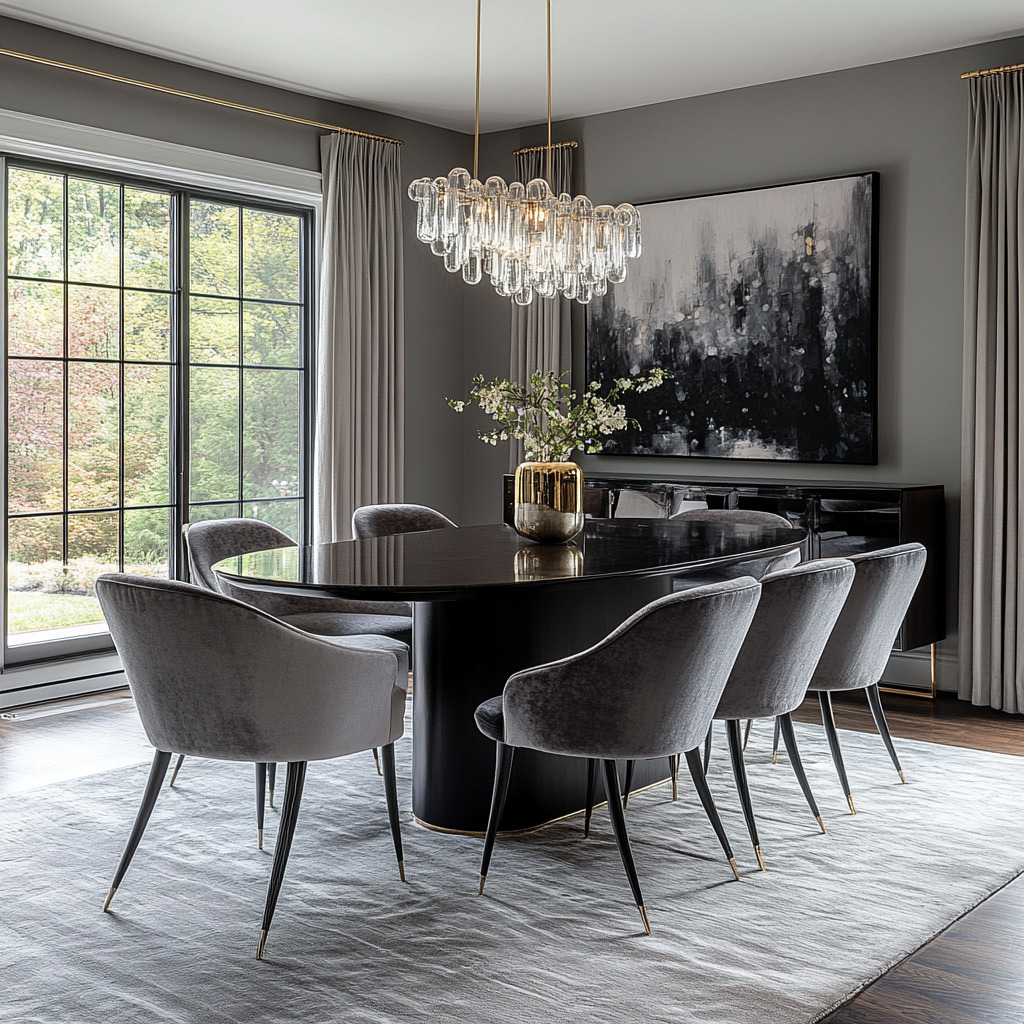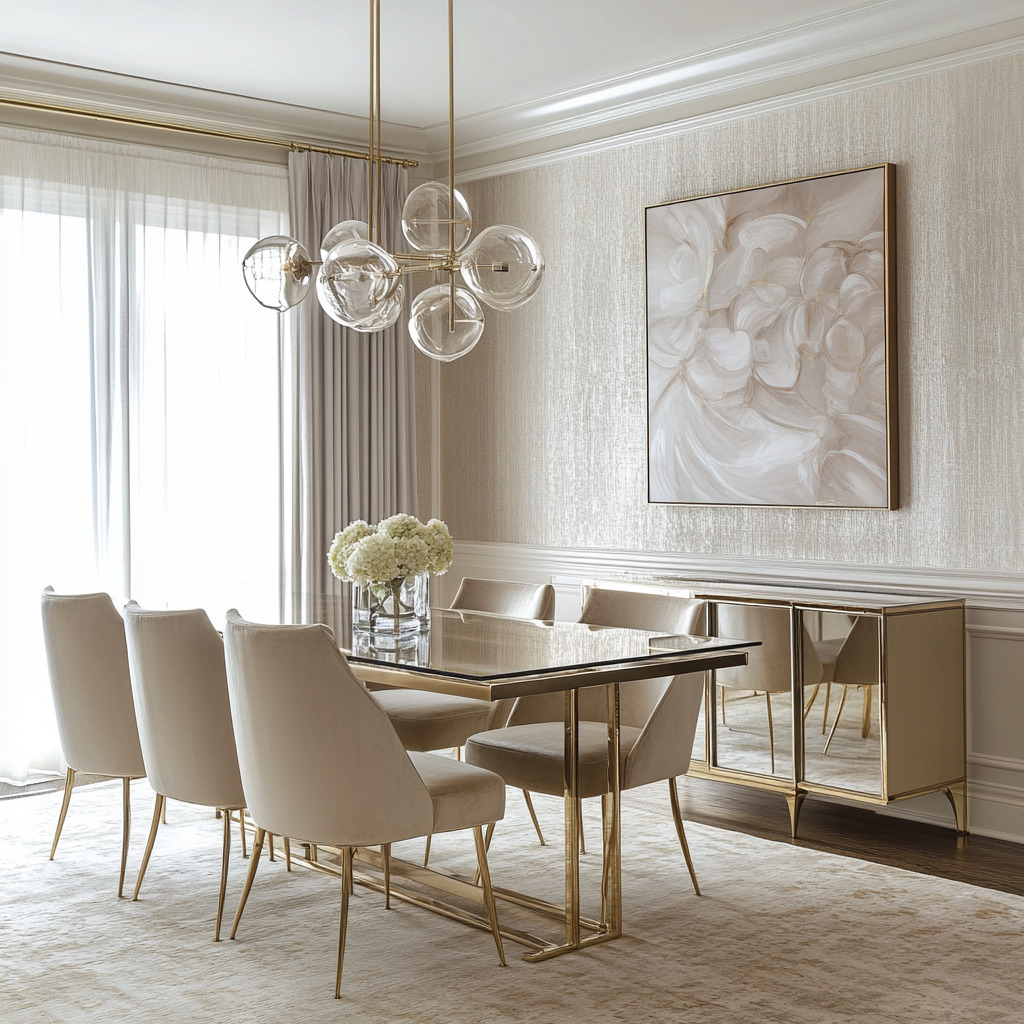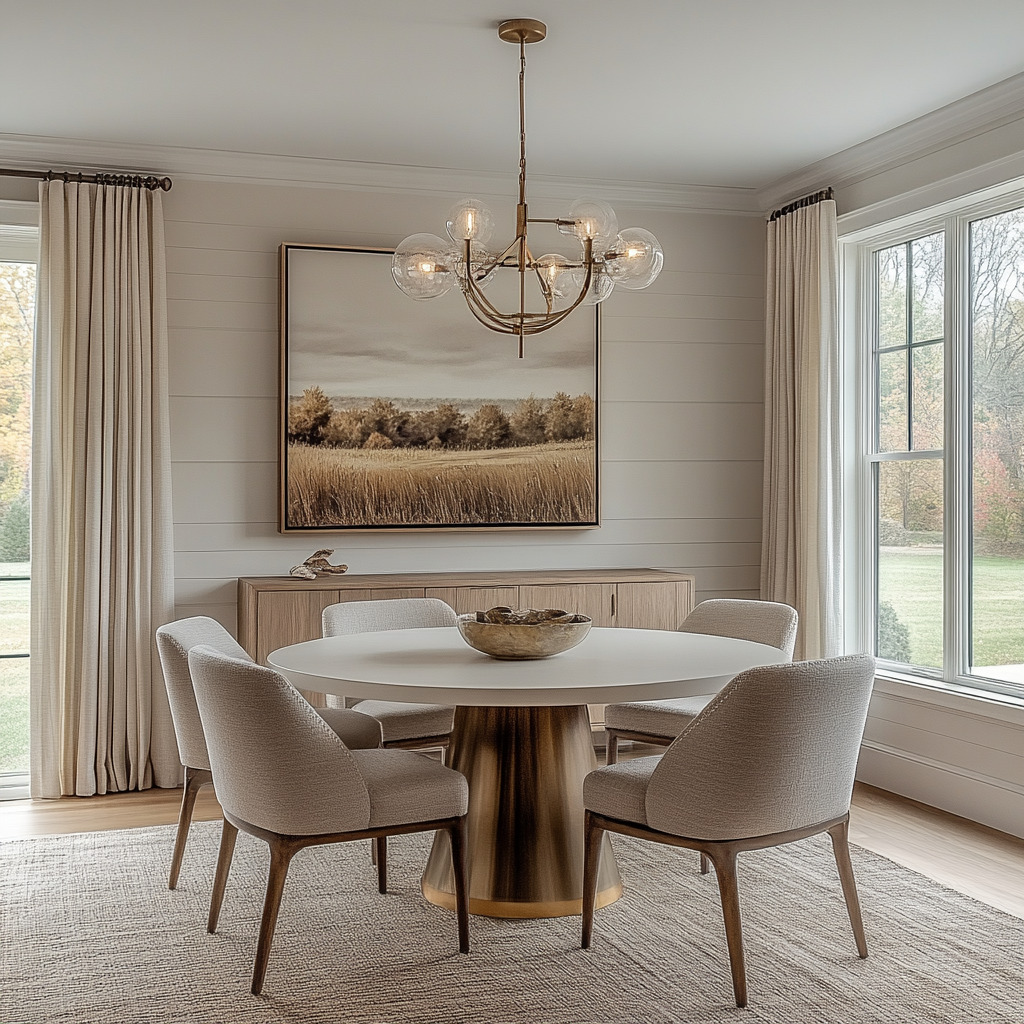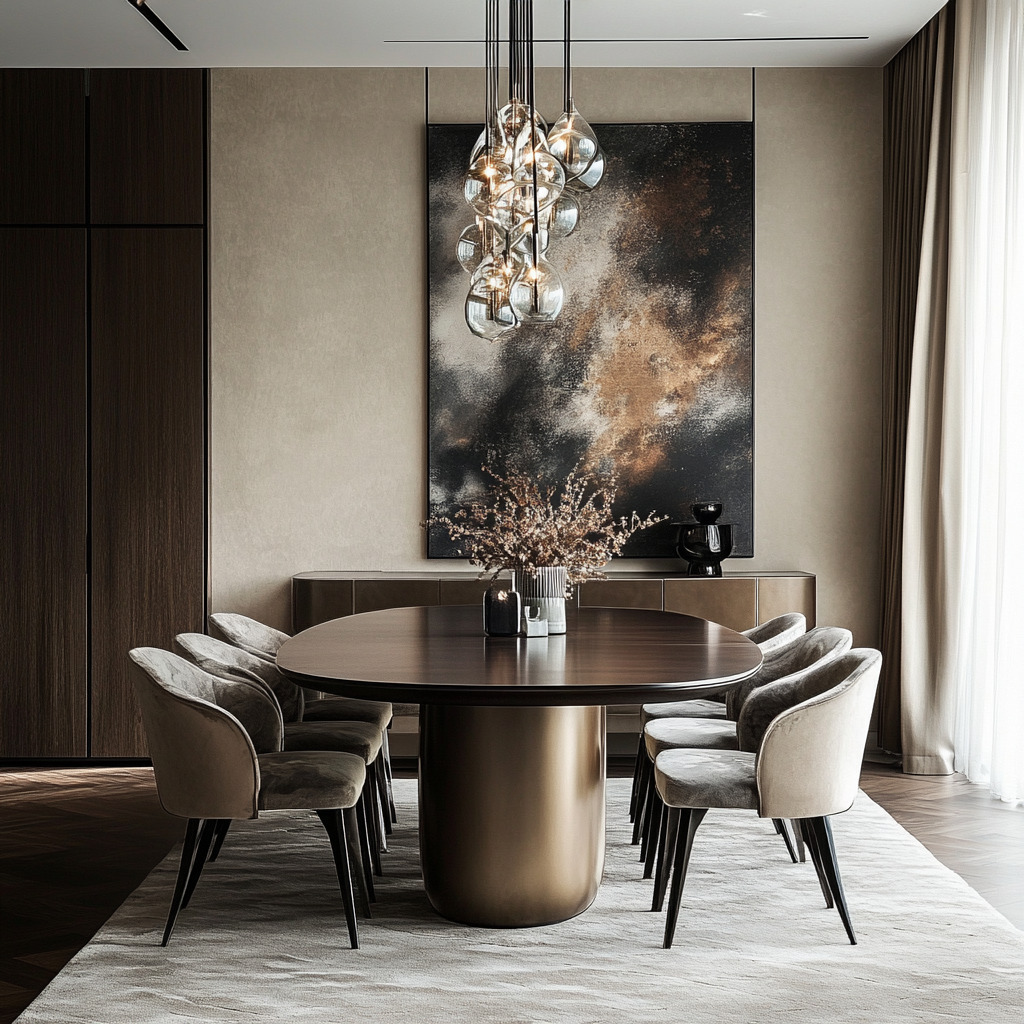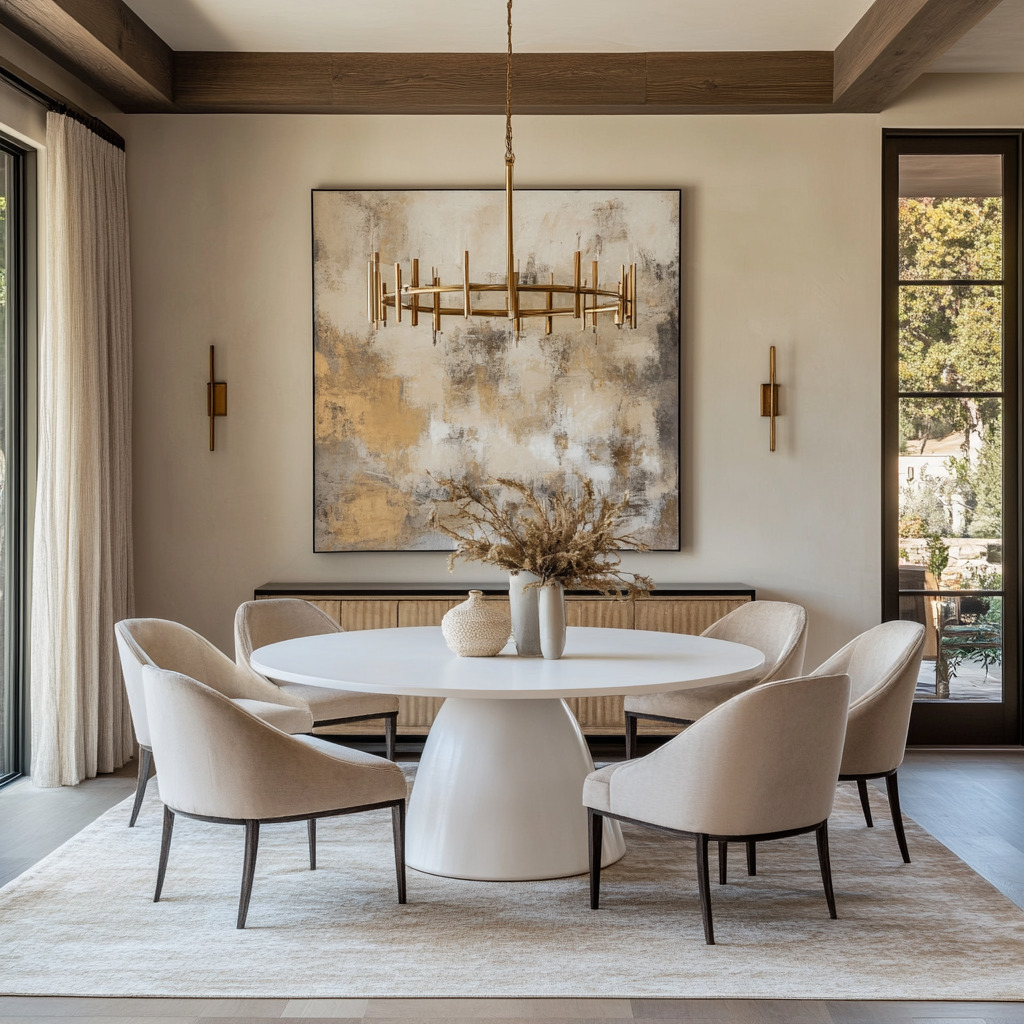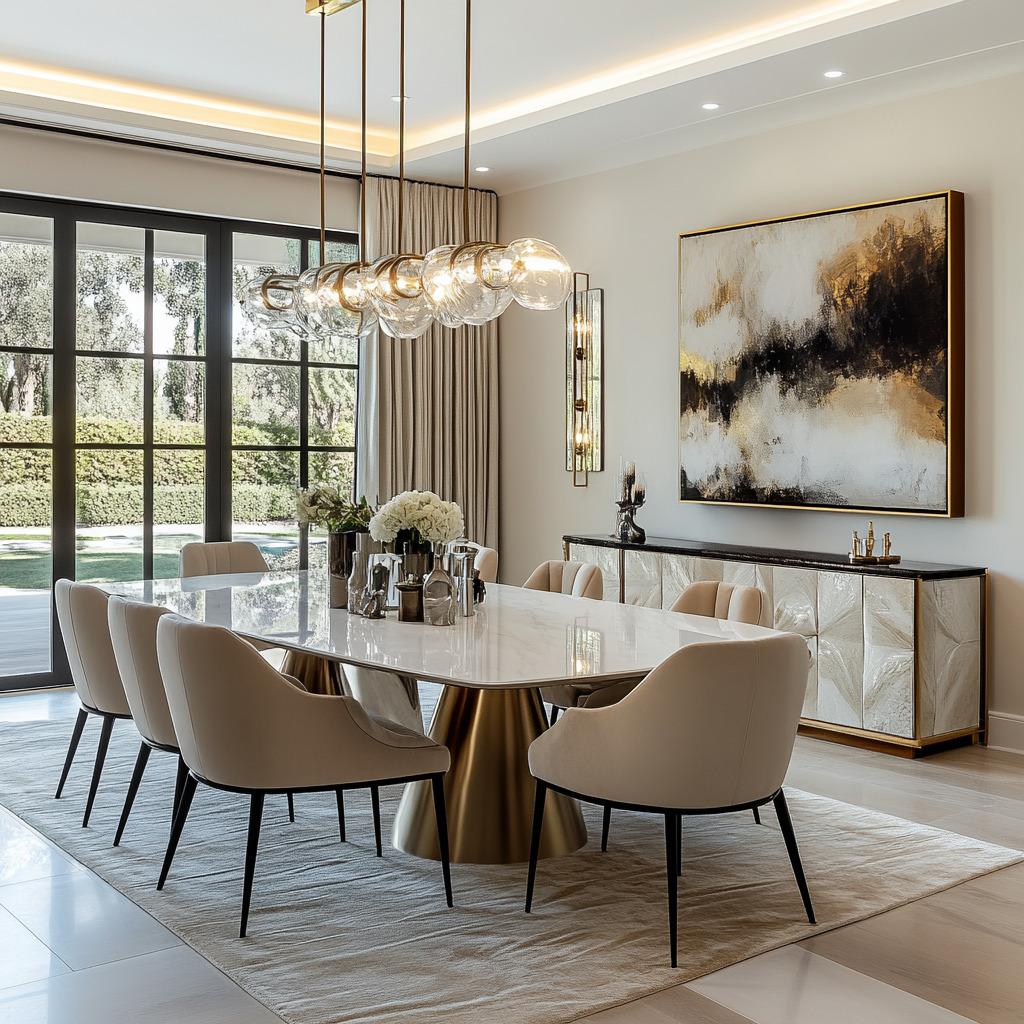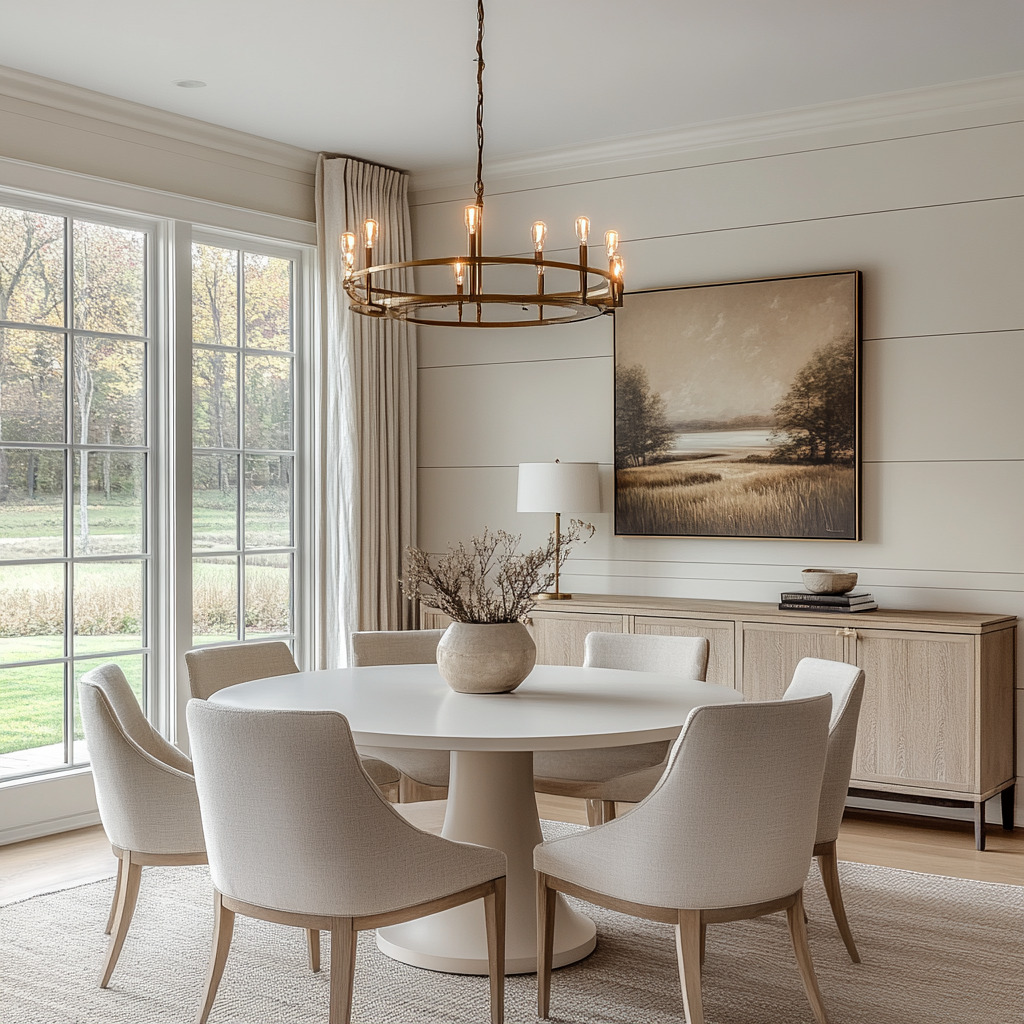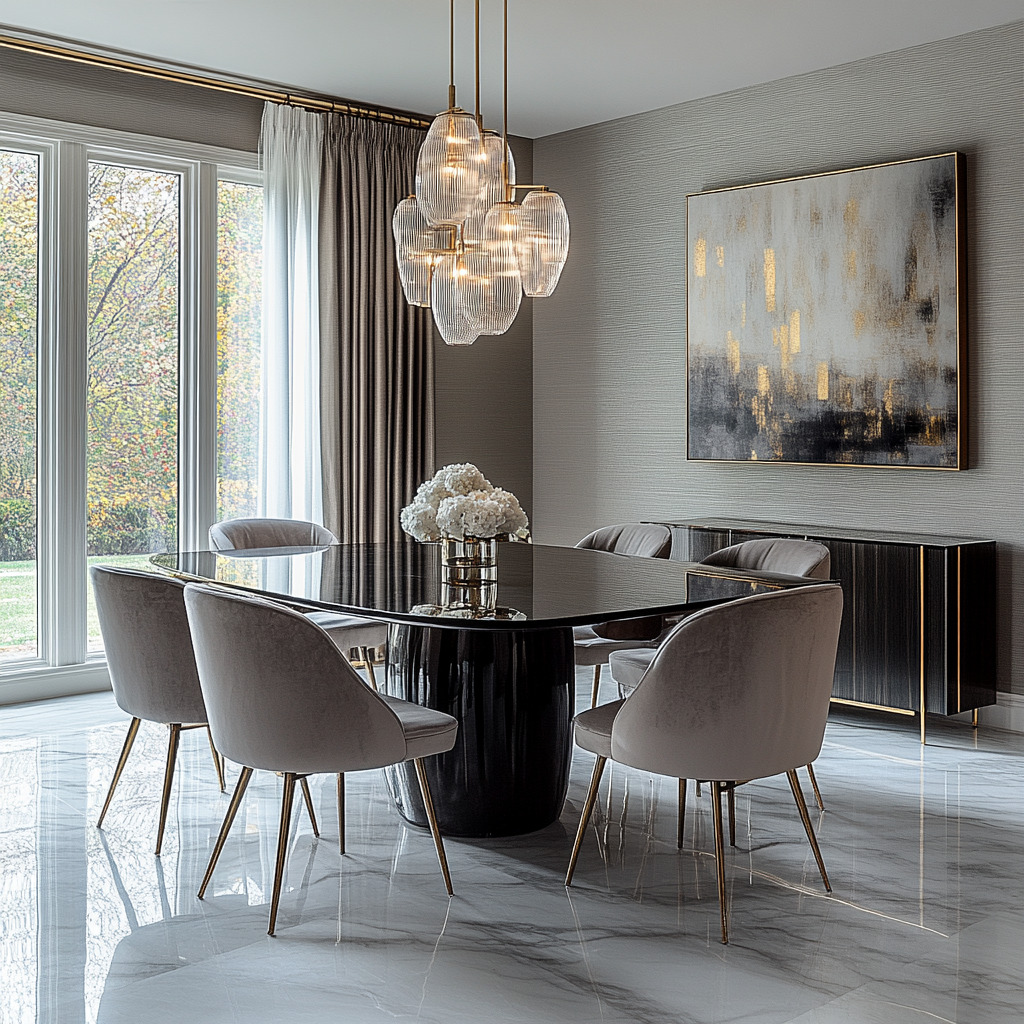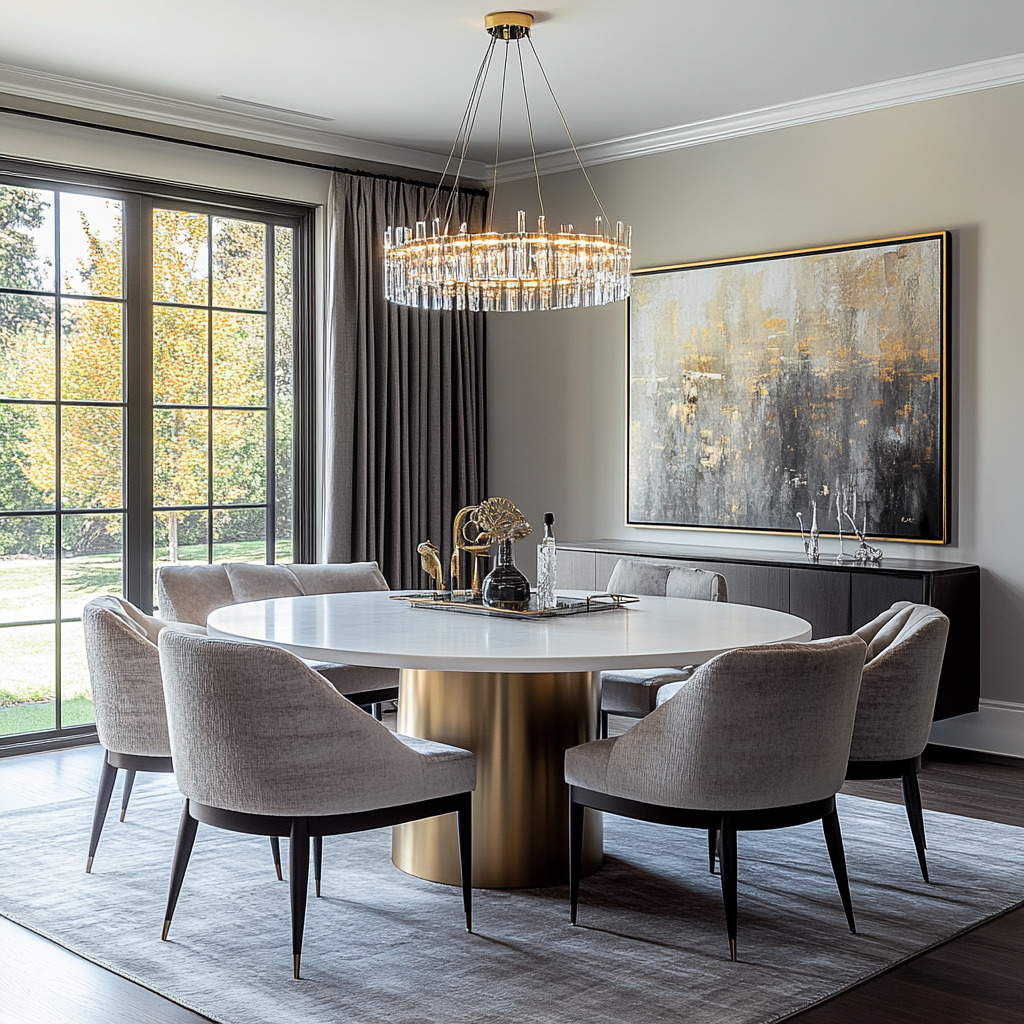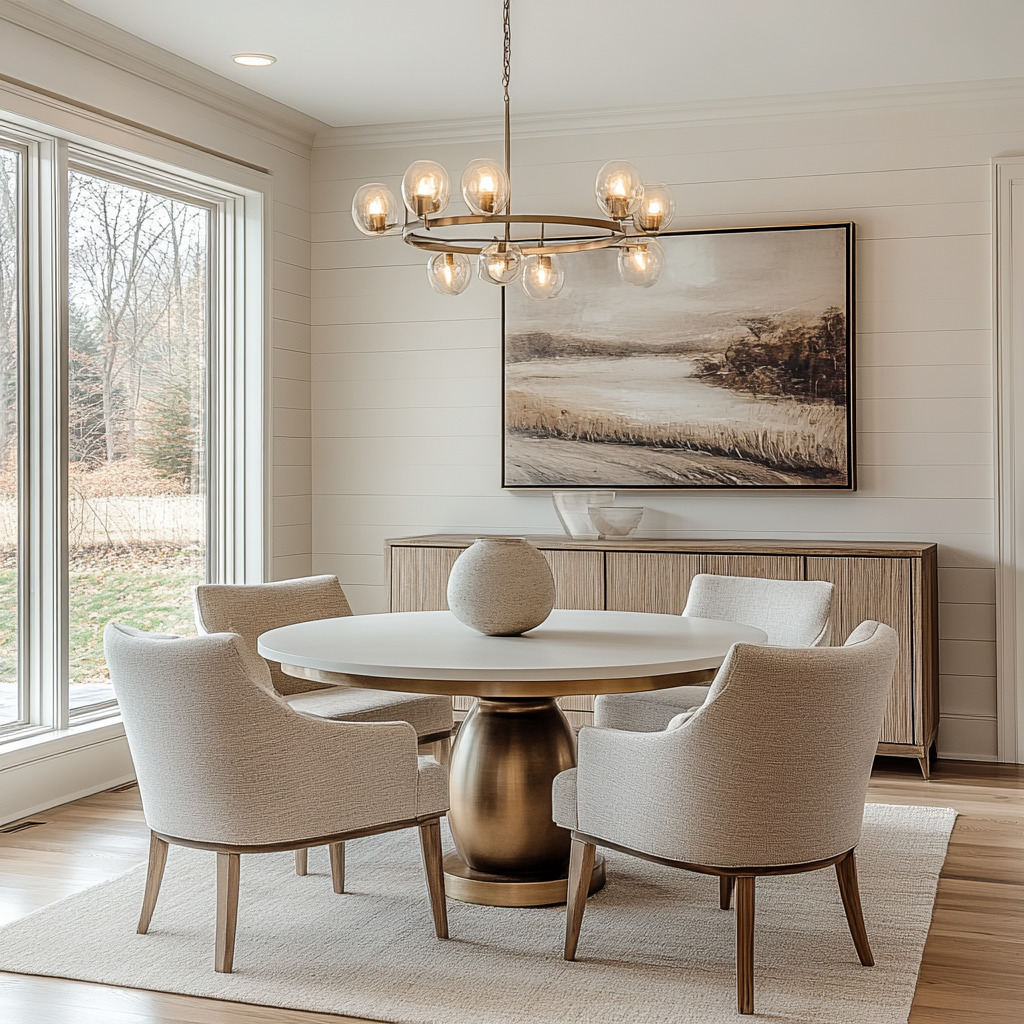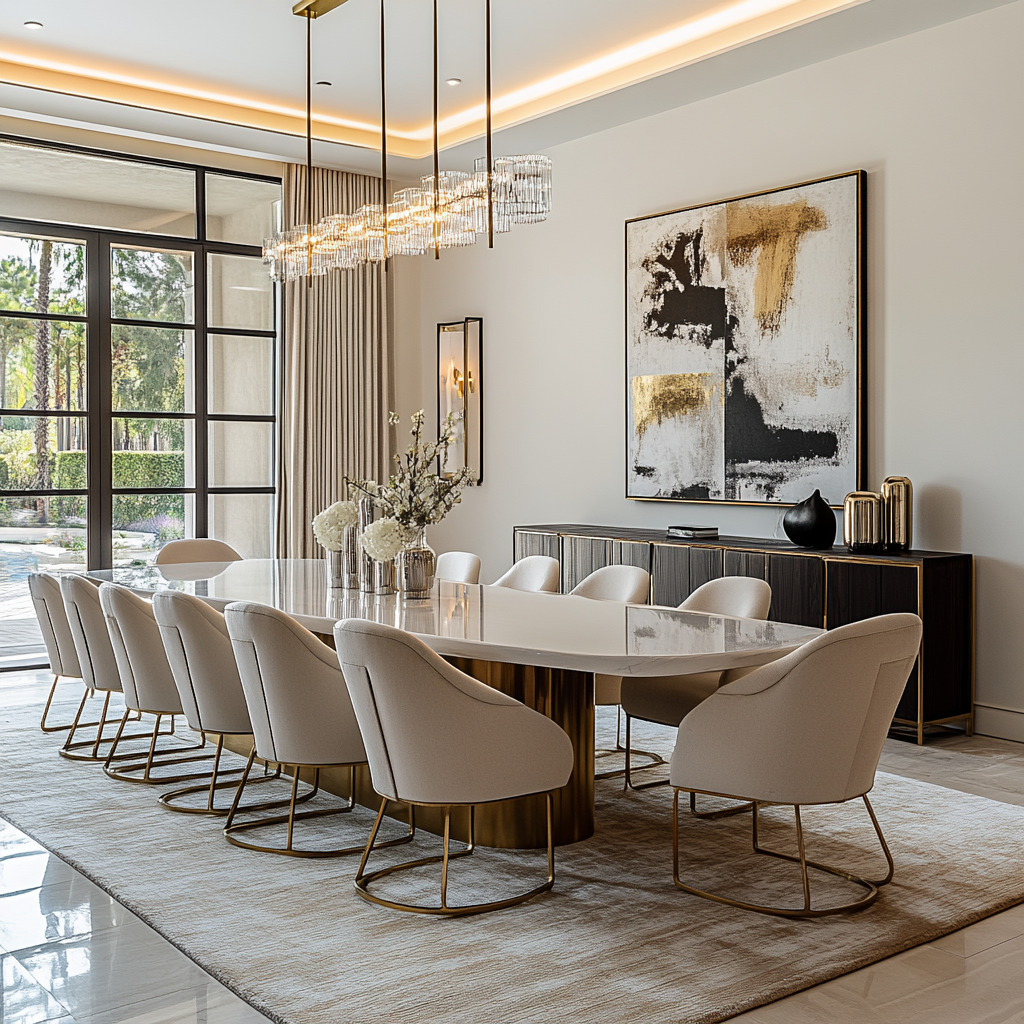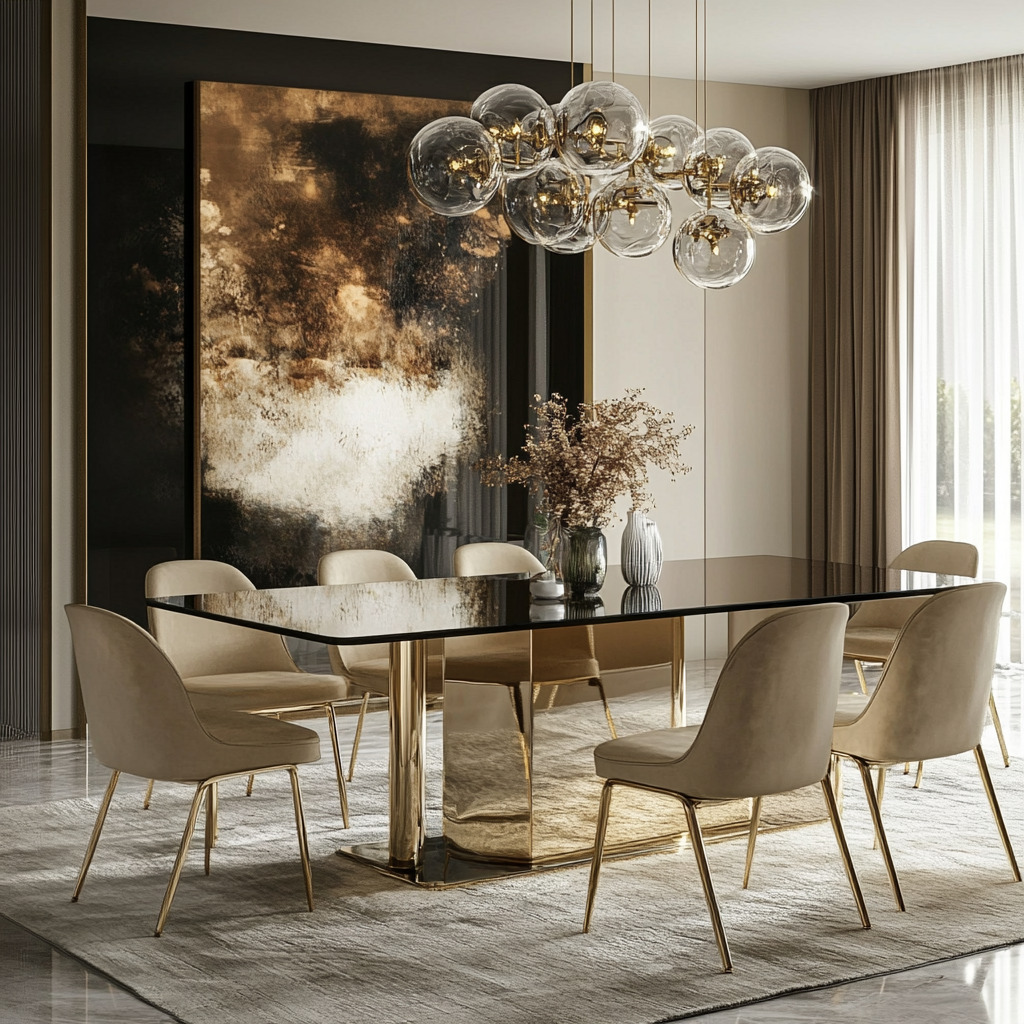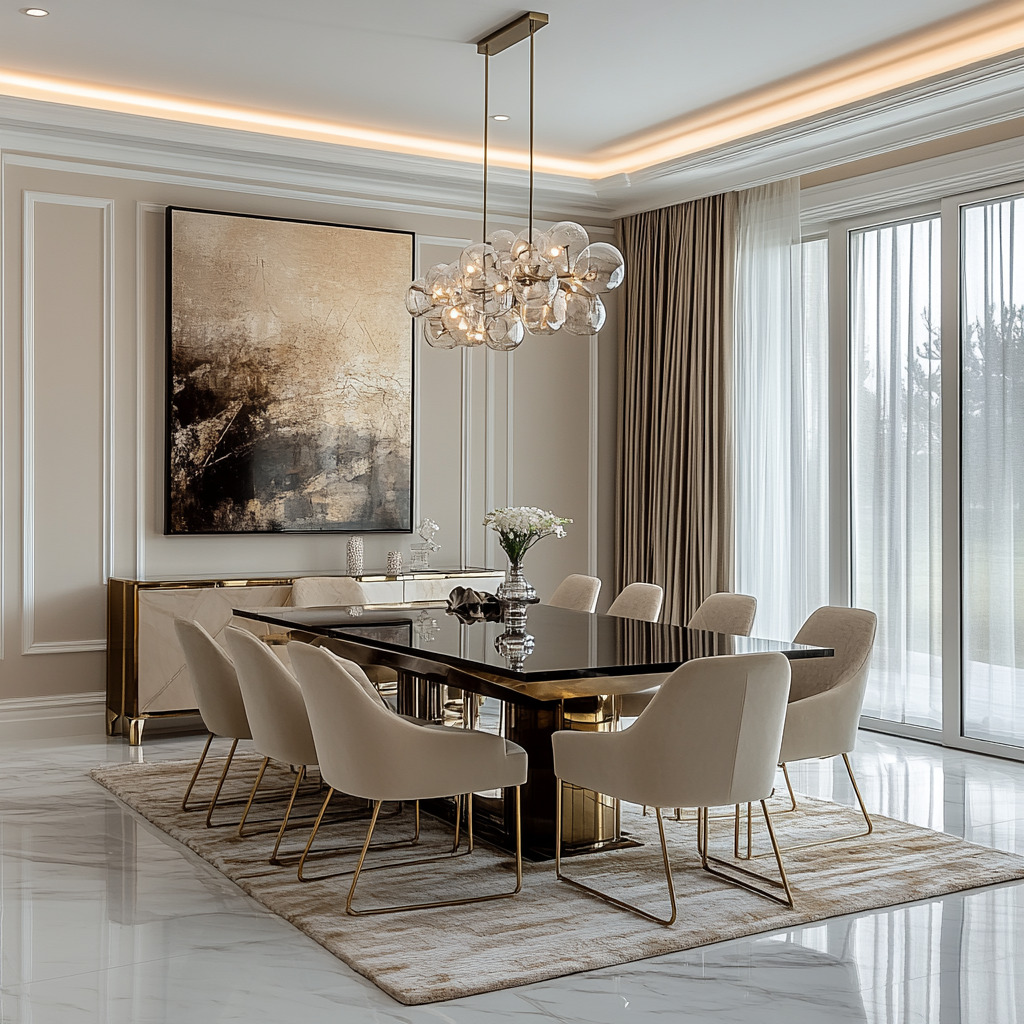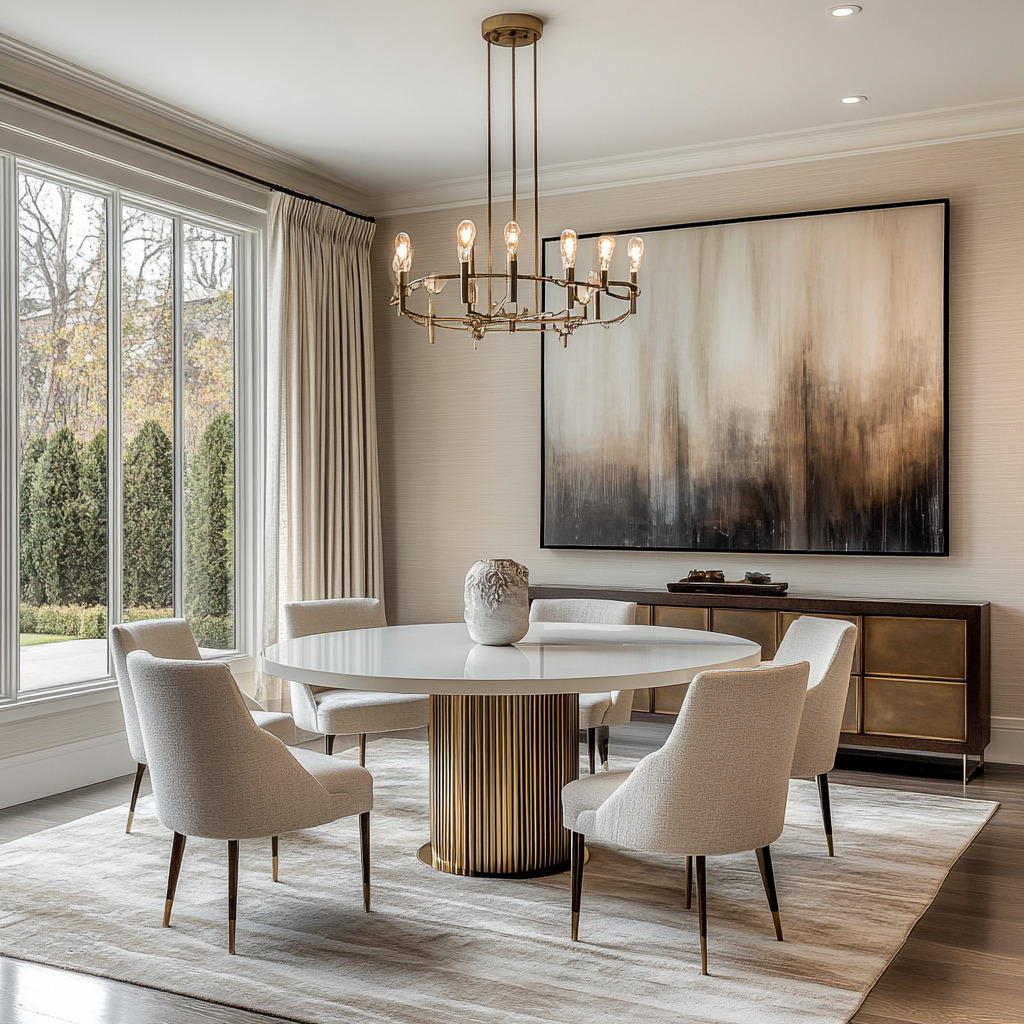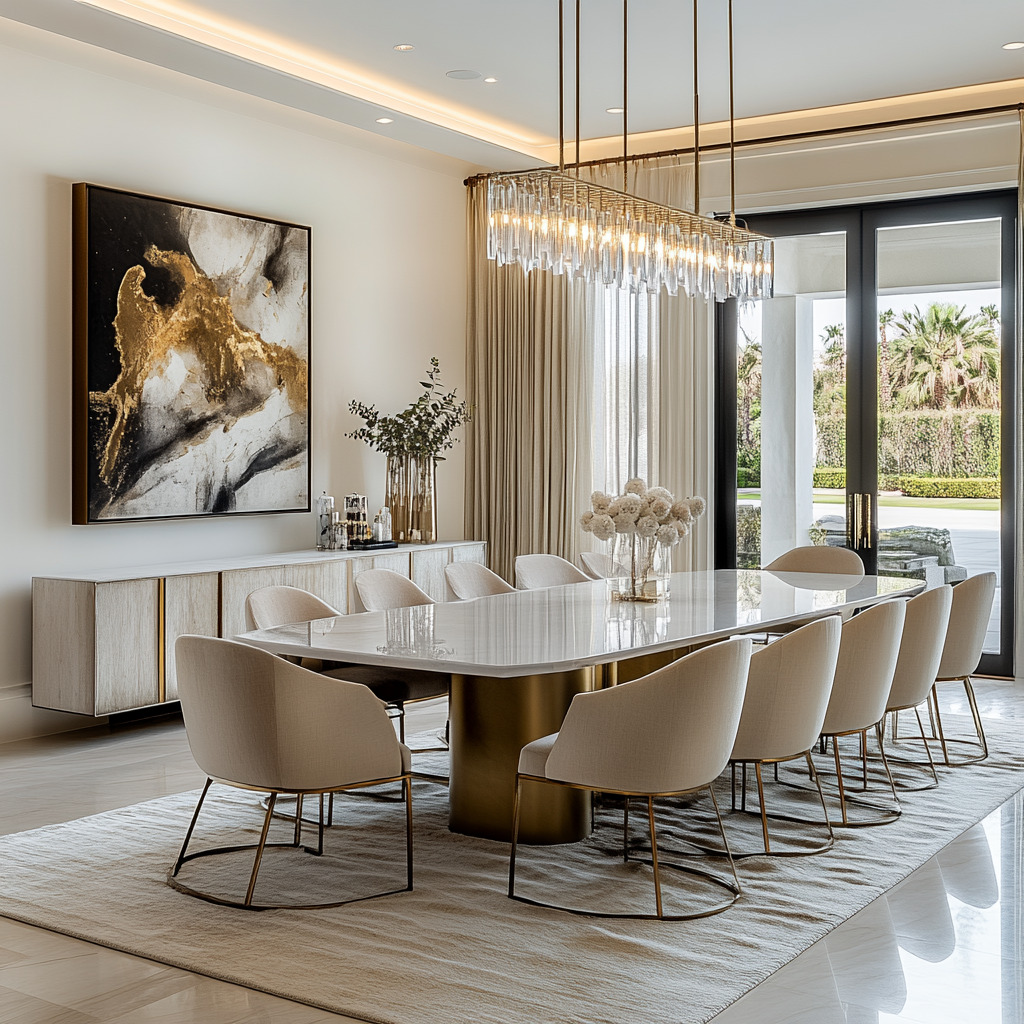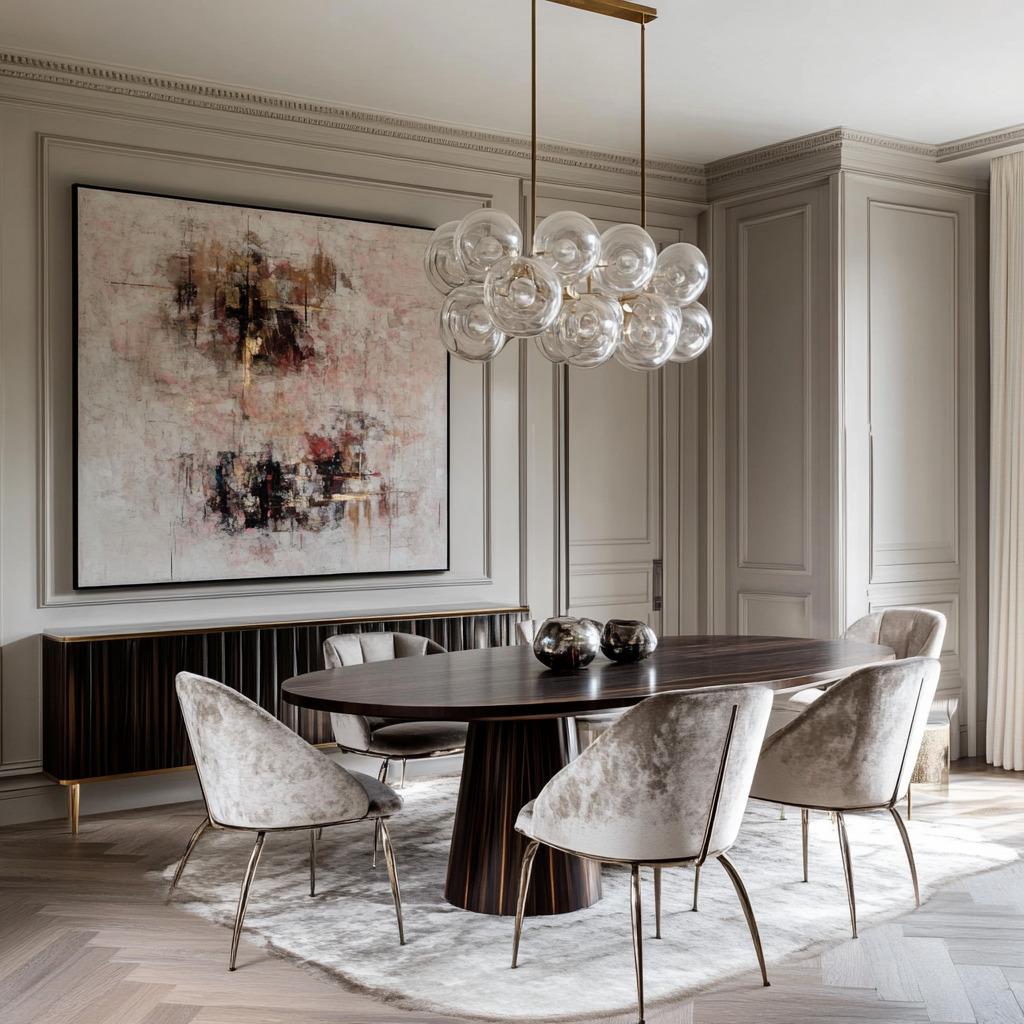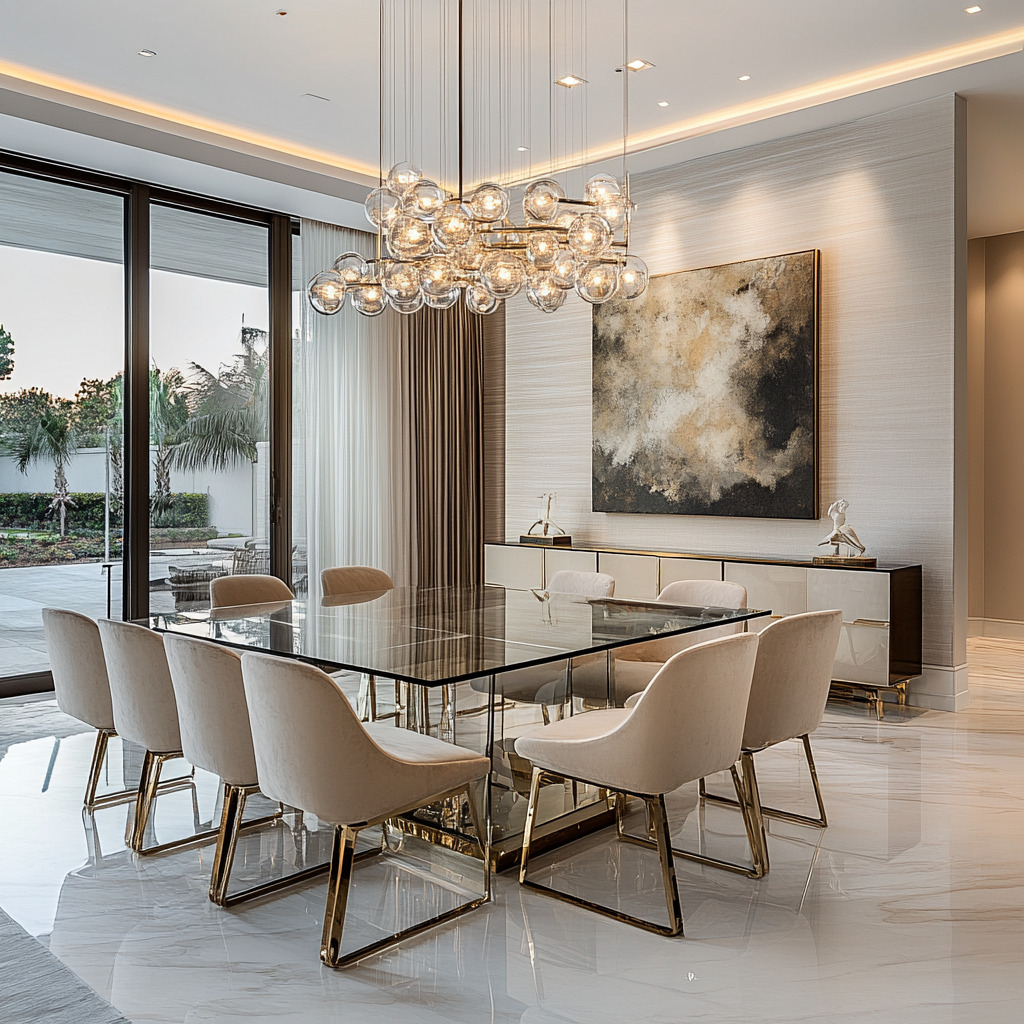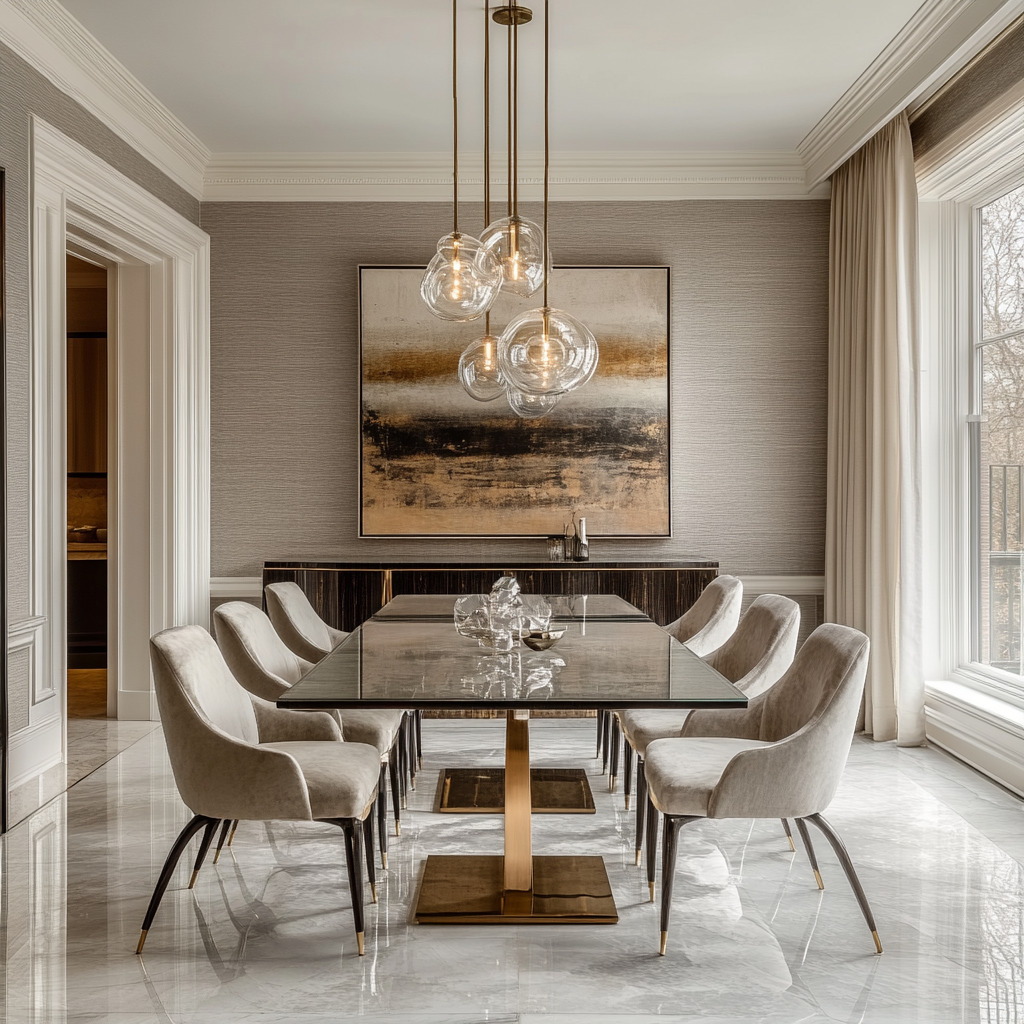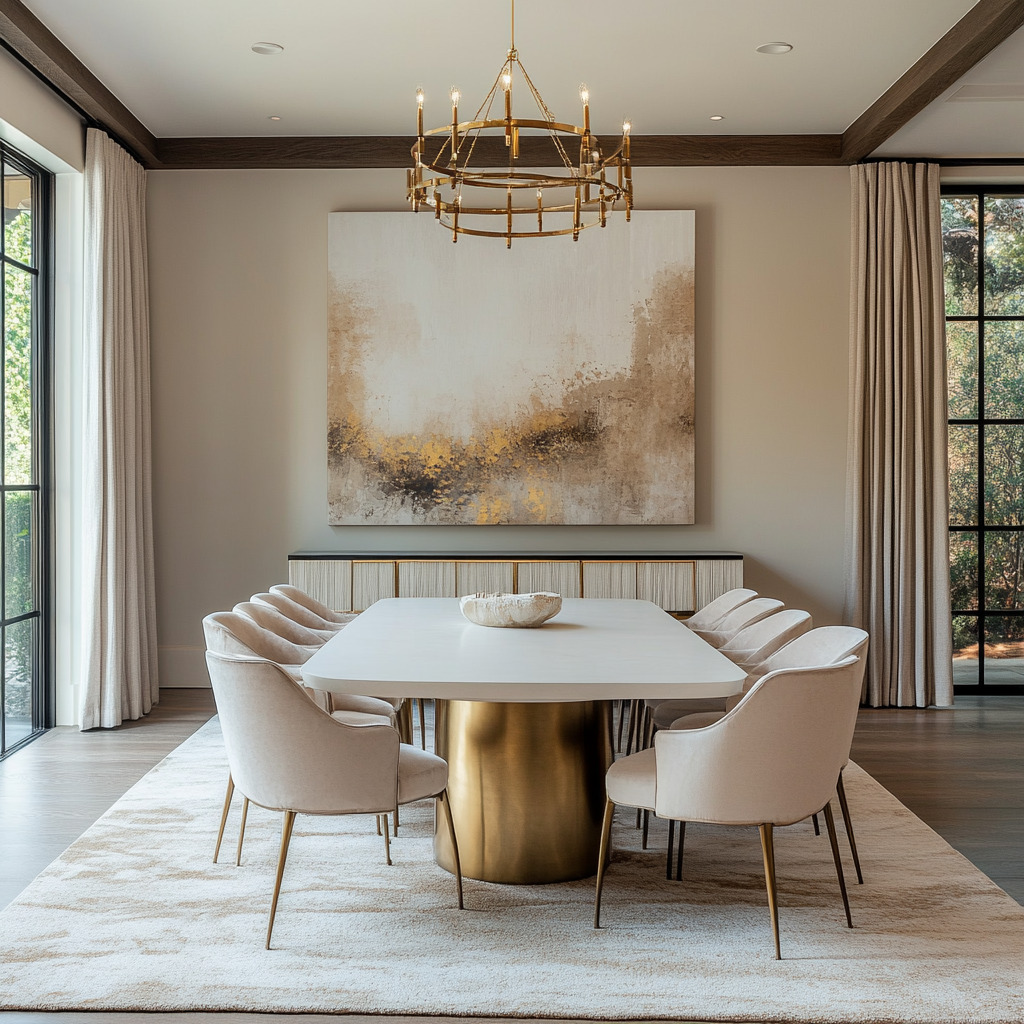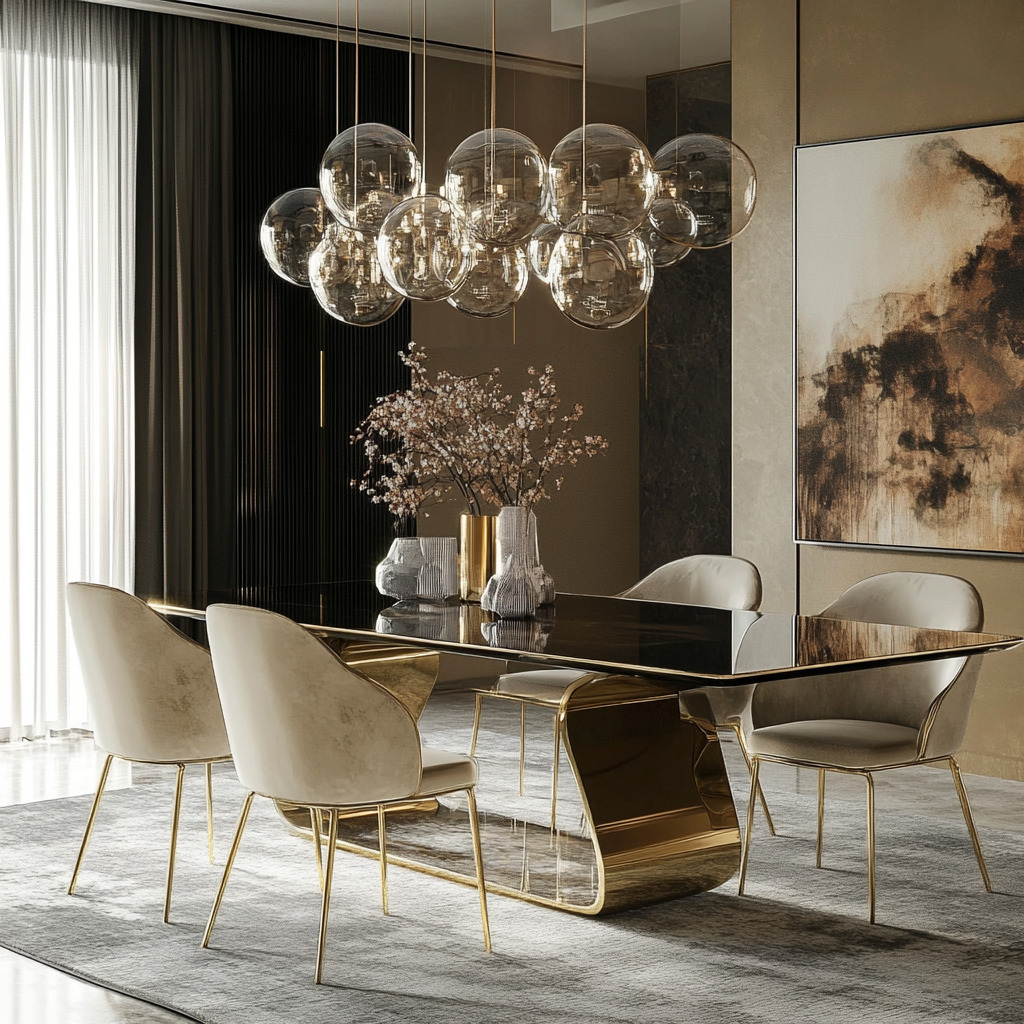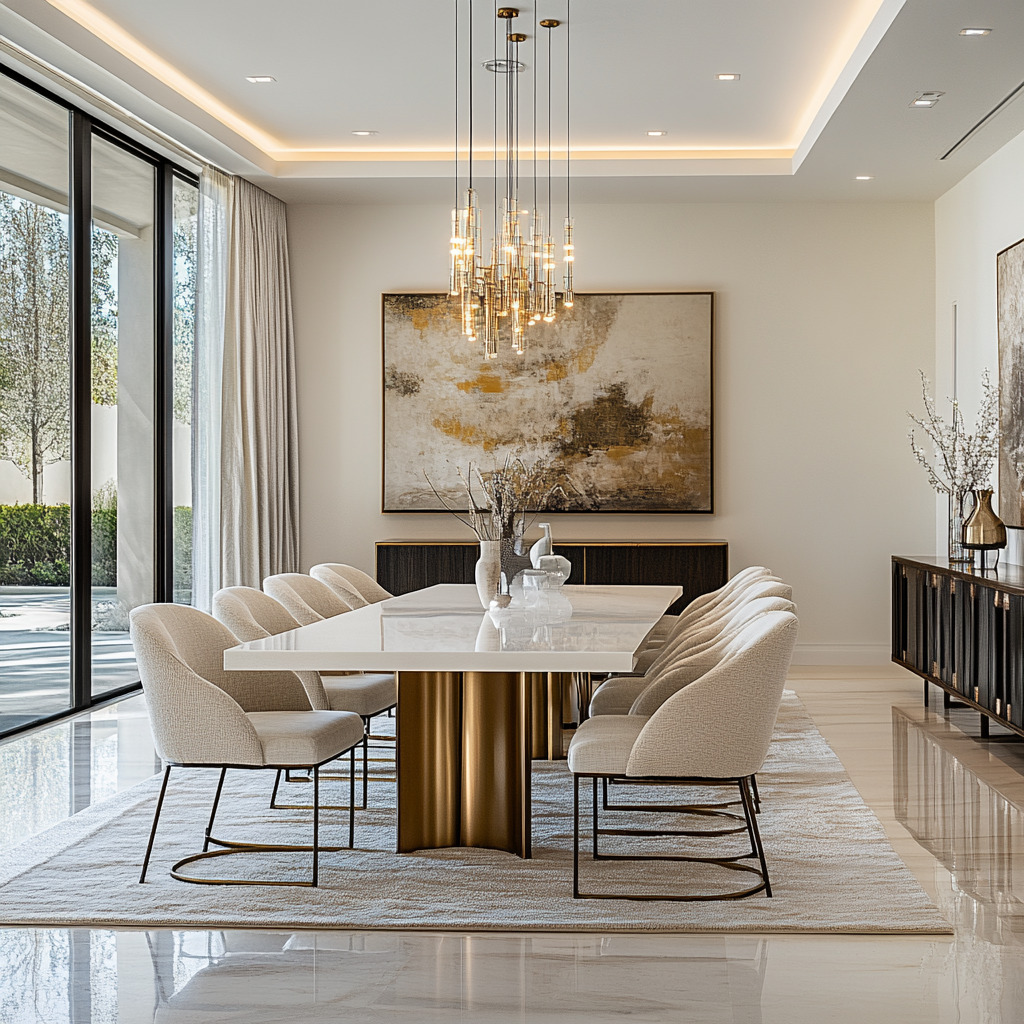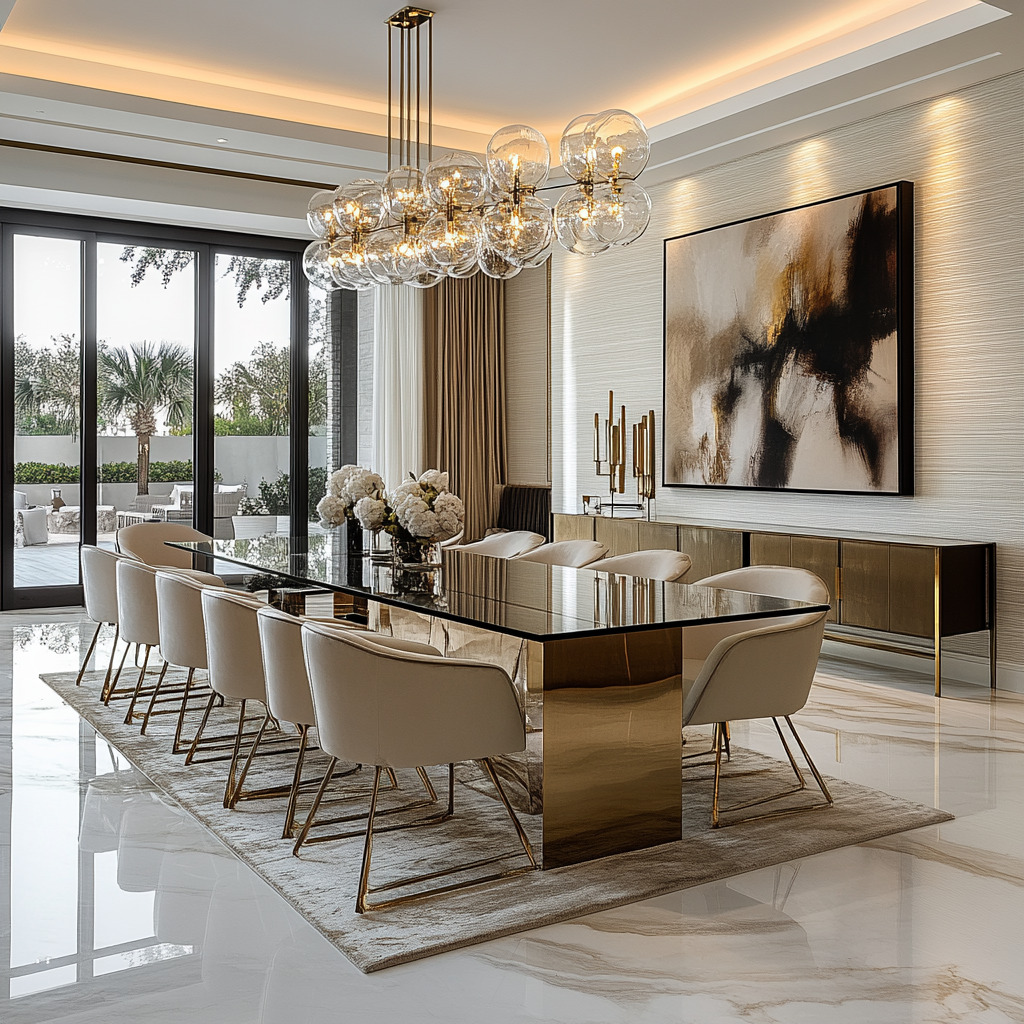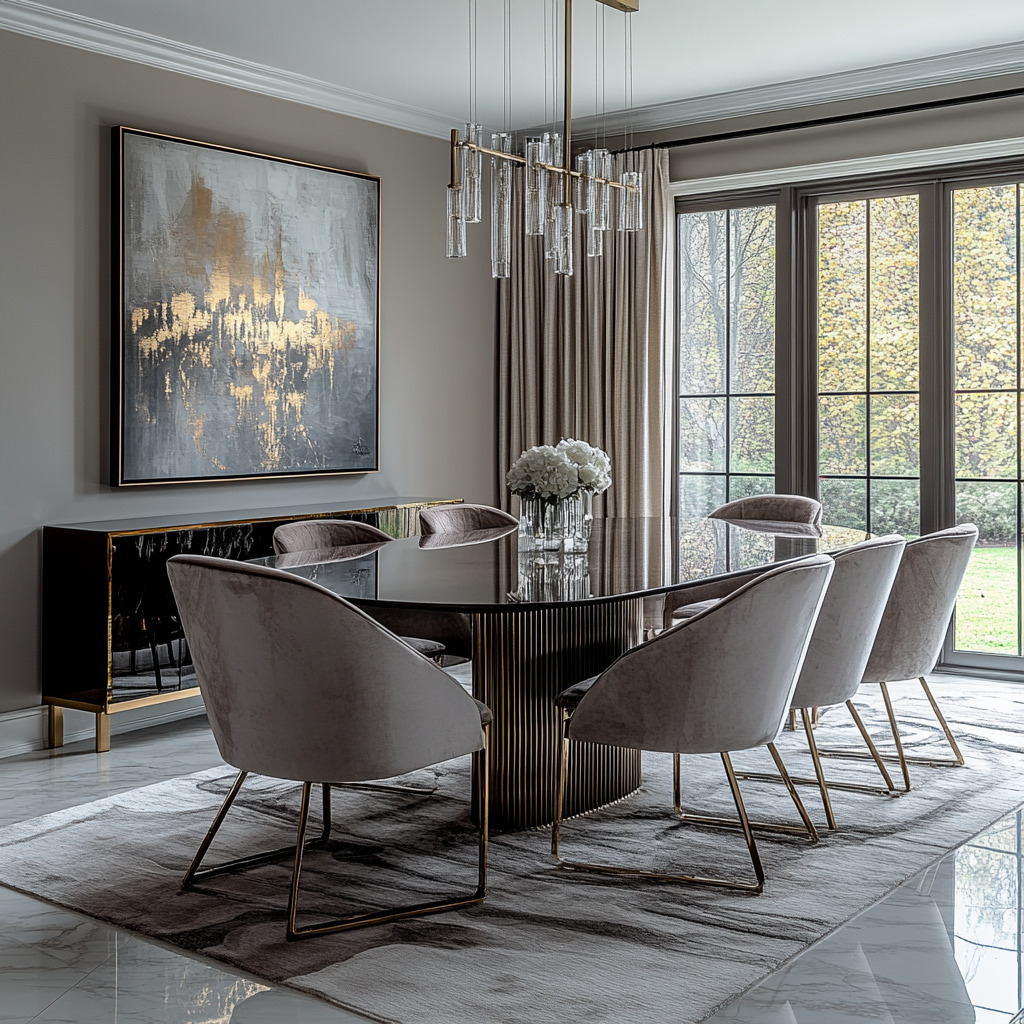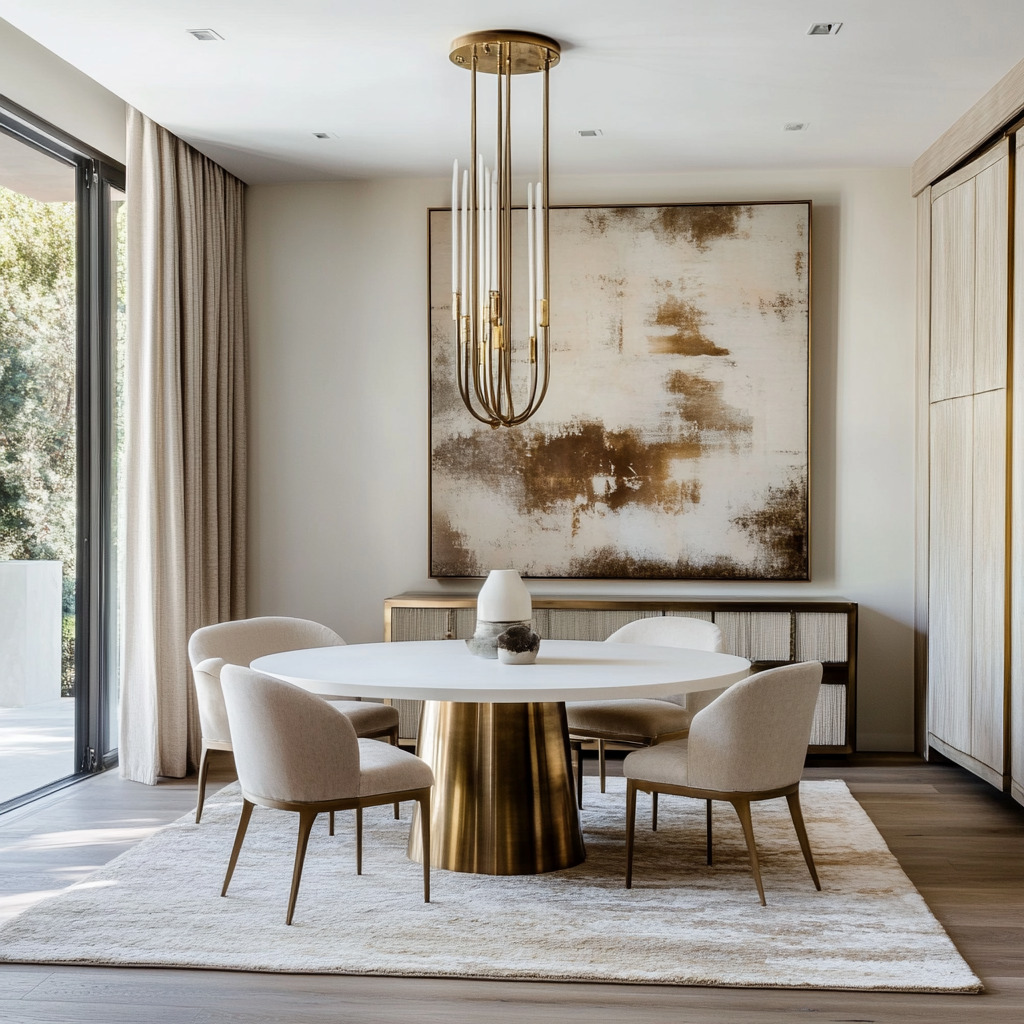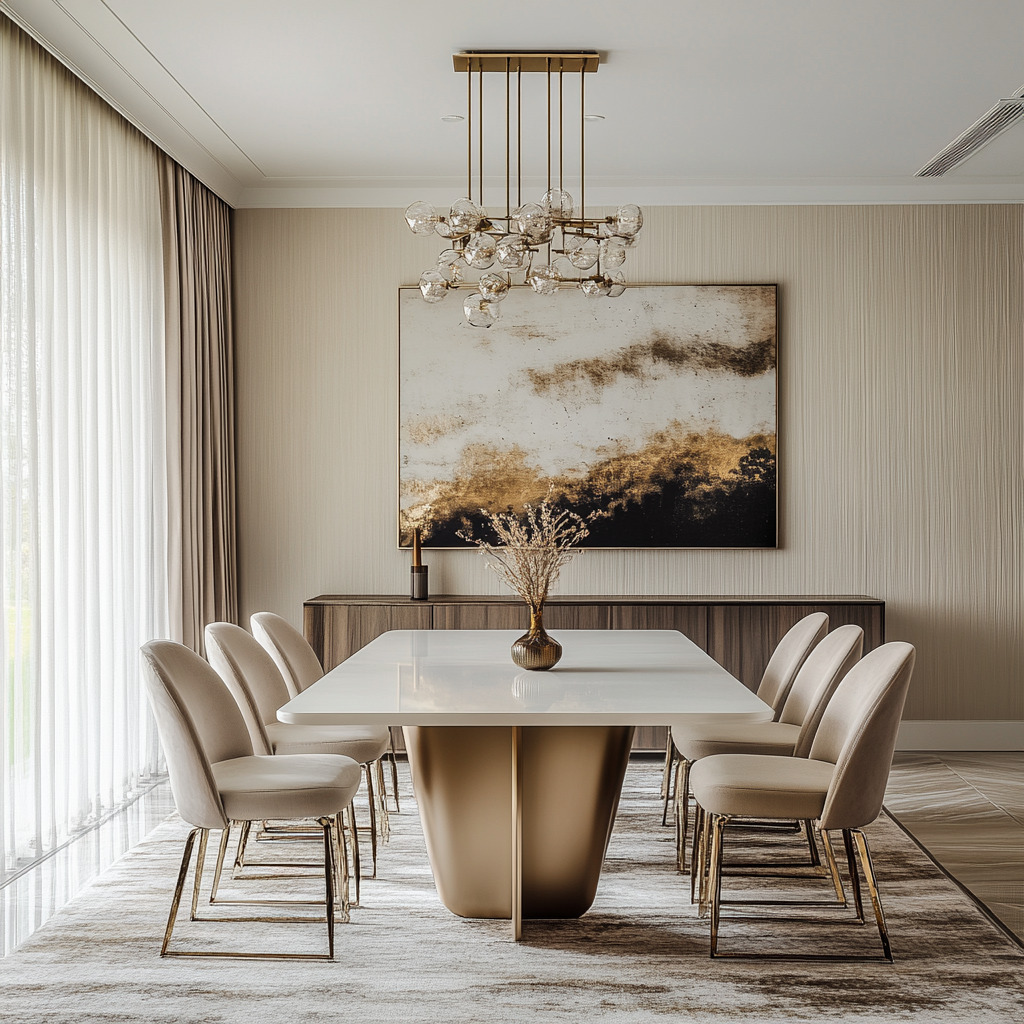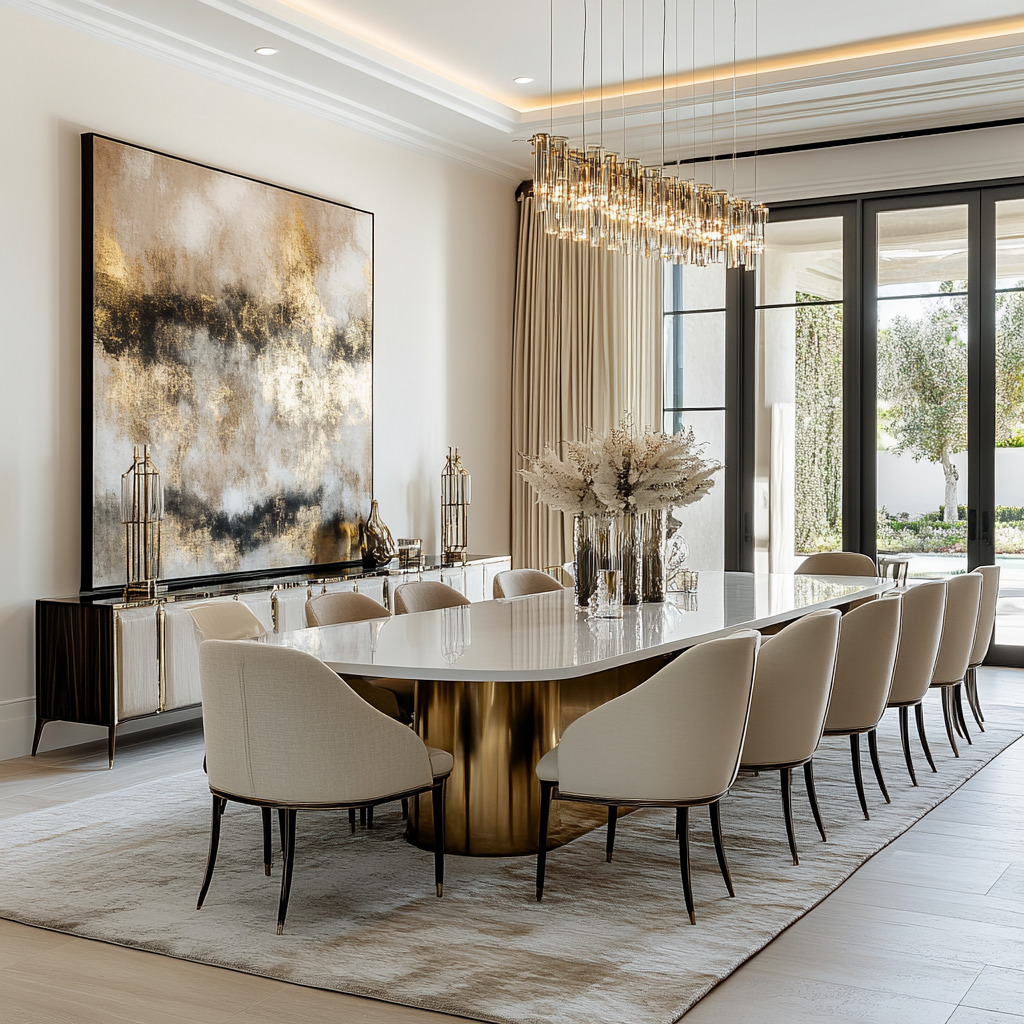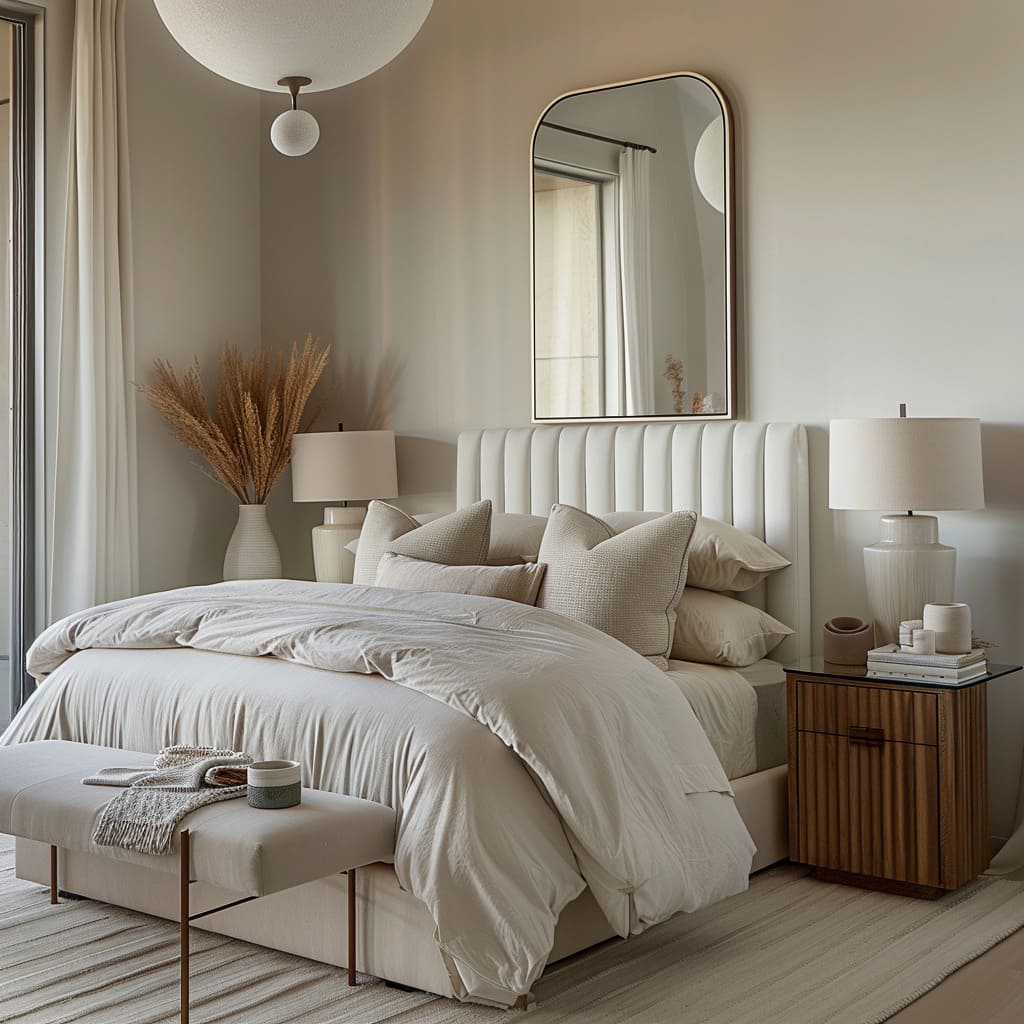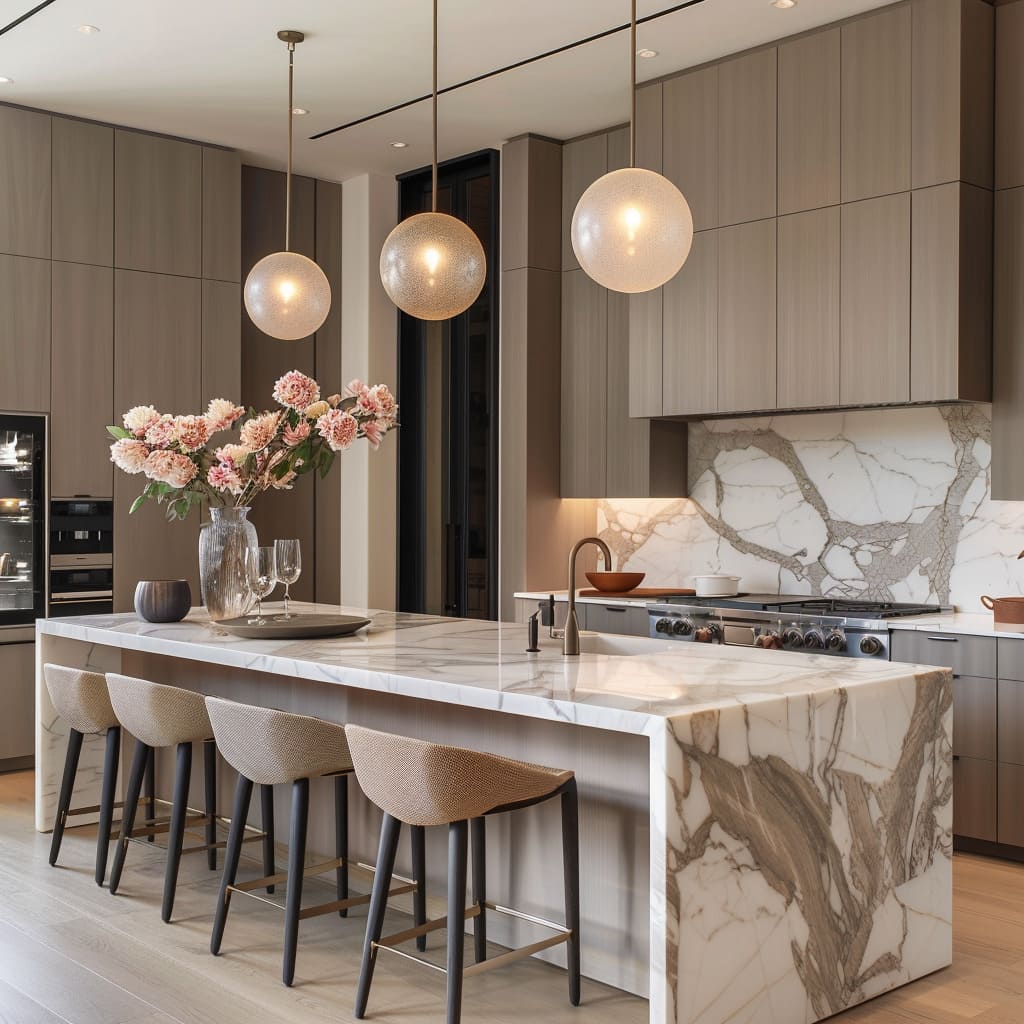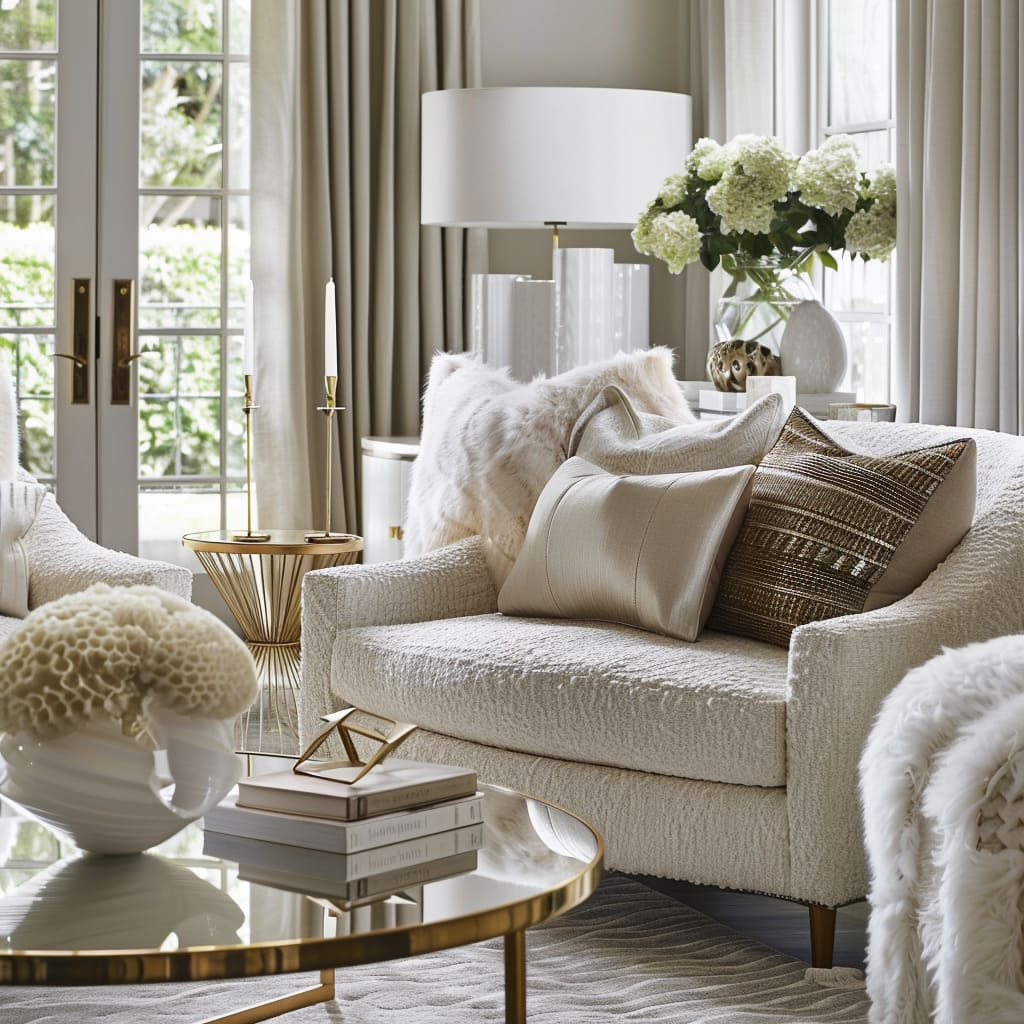Designing a dining room that feels both luxurious and comfortable is no longer reserved for grand homes or elaborate renovations. More and more homeowners are leaning towards creating spaces that bring an upscale look without sacrificing the warmth and coziness that make a house feel like home.
The trend is clear: people want to enjoy the sophistication of high-end design while ensuring that their dining rooms remain welcoming for family dinners or casual get-togethers. In this shift, there’s a growing appeal for transforming a space into something luxurious through thoughtful, accessible choices rather than through exhaustive remodeling efforts.
At the heart of this desire is a balance between opulence and practicality, where the focus is not only on aesthetics but also on the functionality of the room. The goal is to create an environment that feels both impressive and inviting—a space that reflects modern tastes without overwhelming the senses.
This approach speaks to the changing preferences of today’s homeowners, particularly in the U.S., where open-plan living and smart use of materials are key components in achieving this look. It’s about selecting the right elements to create a visually striking dining room with minimal effort
In this article, we’ll take a comprehensive look at how to achieve this luxurious modern style with thoughtful choices. Whether it’s through a carefully chosen color palette, the right statement furniture, or adding impactful lighting, each decision contributes to the overall feel of the room.
The power of texture and how different materials interact in a space can transform even the most ordinary dining room into something that feels far more sophisticated. In the sections that follow, we’ll explore how simple changes, such as introducing modern art, choosing the right rug, or investing in key pieces of decor, can dramatically improve the ambiance of your dining space
Each step outlined will provide clear, practical advice on creating a luxurious dining experience without the need for a full overhaul. From lighting fixtures that double as art pieces to understanding how to layer textures for depth, this guide will offer both inspiration and tangible strategies for making your dining room feel like an upscale retreat.
The best part? You won’t need to knock down walls or take on an extensive project—just a few smart updates will bring your vision to life
Color Palette: Setting the Foundation of Luxury
When aiming for a luxurious dining room design, the color palette is one of the most impactful elements. Choosing the right tones can set the mood, influence how the space is perceived, and create an environment that feels upscale yet comfortable.
A well-thought-out color scheme doesn’t need to be bold or over-the-top to make a statement. In fact, neutral tones such as beige, cream, taupe, and soft gold are at the heart of many sophisticated spaces.
These shades offer a timeless appeal, giving you the flexibility to update other design elements over time without clashing.
Importance of Neutral Tones
Neutral tones have long been regarded as the go-to choice for creating a refined, understated luxury.
Beige, cream, and taupe provide a calming canvas, one that allows other elements in the room to shine while maintaining a cohesive, polished look. These soft tones are not only versatile but also bring a sense of spaciousness and openness to the room, making even smaller dining areas feel more expansive.
They create a backdrop that is subtle yet impactful, allowing you to layer textures and materials with ease
One of the key benefits of neutral colors is the ability to adapt to different decor styles and trends over time. Whether you decide to change out your dining chairs, add bolder art, or introduce metallic finishes, neutral walls and foundational furniture will always provide the flexibility you need.
This makes neutrals particularly useful for homeowners looking to create a high-end space without the risk of elements clashing or feeling outdated. In this way, neutral tones serve as a long-lasting investment in the overall aesthetic of your home.
Contrasts with Darker Elements
While neutrals lay the groundwork for a serene dining room, the introduction of darker accents brings contrast and depth, giving the room a more dynamic feel.
For instance, a rich black or deep brown dining table can serve as a bold statement piece that anchors the room and draws the eye in. This contrast is not just about aesthetics—it’s about creating visual interest and balance.
When paired with lighter chairs or surrounding decor, these darker elements create a striking contrast that elevates the sophistication of the space. Think of a glossy black dining table set against a backdrop of soft beige walls.
The difference in tone immediately grabs attention, while still maintaining an air of refinement. Dark accents, whether in furniture, fixtures, or decor, bring a sense of depth and richness, ensuring that the space feels layered rather than flat.
These contrasts can also extend to smaller details like dark-framed artwork, black curtain rods, or even deep-colored accessories. The careful balance between light and dark tones helps give the room a grounded yet elevated appearance.
Creating Warmth Through Color
To avoid the risk of the room feeling too stark or cold, incorporating warm tones, such as gold or bronze accents, can instantly lift the mood of the space. Warm metallics, in particular, are often associated with luxury, and for good reason—they reflect light beautifully and add a sense of opulence without overwhelming the senses.
Gold finishes on table legs, lighting fixtures, or decorative vases can bring subtle elegance to the room, complementing the neutral base while adding a touch of warmth
Golden or bronze tones also have the unique ability to transform a minimalist space into something that feels more welcoming and upscale. Whether it’s through the introduction of a gold chandelier, bronze detailing on a sideboard, or a gold-accented piece of art, these warm hues soften the overall look and invite warmth.
They also pair beautifully with both light and dark elements, enhancing the contrast between neutral walls and bolder furniture. By using warm tones strategically, you can create a luxurious environment that feels inviting rather than formal.
The warmth balances out the cooler, more neutral colors, ensuring that the room remains both sophisticated and cozy. These accents, though often subtle, make all the difference in achieving the high-end look you’re after while keeping the dining room functional and approachable for everyday use.
In summary, neutral tones lay the foundation for a luxurious space, offering versatility and timelessness. Darker accents introduce depth, creating a visual contrast that enhances the room’s sophistication, while warm tones elevate the space with a welcoming glow, ensuring that the room remains inviting.
Together, these elements form the backbone of a modern, luxurious dining room that feels balanced, stylish, and effortlessly elegant
Furniture Selection: Key to a Luxurious Modern Dining Room
The furniture you choose plays a critical role in shaping the aesthetic and feel of your dining room. In any dining space aiming for a high-end, modern look, the selection of furniture serves as the cornerstone of the room’s overall design.
When done thoughtfully, the dining table and chairs not only define the function of the room but also establish its character and elegance. From selecting the perfect dining table to choosing chairs that blend comfort with style, furniture is key to creating a space that feels luxurious and practical.
The Dining Table as the Focal Point
At the heart of every dining room is the dining table, which acts as the primary anchor and focal point of the space. A statement dining table has the power to set the tone for the entire room, so its shape, material, and finish are crucial in creating a luxurious ambiance.
Opting for a rectangular or oval dining table can add both elegance and versatility, depending on the size and layout of your room. Rectangular tables, especially with sleek edges or bold metallic bases, bring a sense of modern sophistication, while their length ensures practicality for larger gatherings.
They give a structured look to the room and provide ample space for seating, creating an atmosphere that feels grand. On the other hand, oval tables offer a softer, more organic shape, which can lend the room a sense of fluidity and comfort.
The absence of sharp corners makes them a versatile choice for both formal and casual settings
When it comes to material, glossy black surfaces, glass tops, metal accents, or rich woods are excellent choices for achieving a refined look. Glossy black tables, with their sleek, polished finish, add an undeniable air of modern luxury, while glass tops reflect light beautifully, opening up the room and making it feel even more spacious.
Metal bases, particularly in gold or brass, bring a glamorous edge to any dining setup, as they add shine and visual interest without overpowering the room. If your aesthetic leans more towards natural tones, a solid wood table in rich, dark tones offers a timeless, understated elegance, grounding the room with warmth and character.
No matter the shape or material, the dining table should serve as a bold yet balanced centerpiece, commanding attention while allowing the rest of the room to complement its style.
Stylish Dining Chairs for Comfort and Elegance
If the dining table is the anchor, the chairs are what bring the room together, both visually and functionally.
Choosing the right dining chairs is just as important as selecting the table, as they provide not only seating but an opportunity to introduce texture, color, and design details that enhance the overall luxury of the space. Upholstered chairs in velvet or soft fabric finishes are a popular choice for modern dining rooms aiming for an upscale look.
Velvet, in particular, brings a rich texture and a sense of opulence that immediately elevates the room’s ambiance. The softness of velvet contrasts beautifully with harder materials like glass or metal, adding warmth and comfort to the space.
Even if velvet isn’t your material of choice, other fabric finishes like linen or suede can also introduce comfort without sacrificing elegance. The legs of the chairs are another important consideration.
Slim, gold-tipped legs or other metallic finishes, such as brass or chrome, can add an element of refinement. These details make the chairs feel like more than just functional pieces; they become part of the room’s overall design statement.
The metal legs not only provide contrast but also contribute to the modern, polished look of the space. Gold or brass accents, in particular, pair beautifully with neutral or darker color palettes, reinforcing the sense of luxury.
If your dining table features a bold metallic base, chairs with complementary legs will enhance the room’s cohesive look
The design of the chair should also be ergonomic, providing comfort without compromising on style. Chairs with slightly curved backs, plush seats, and supportive cushioning ensure that guests feel comfortable during long meals, while maintaining a clean, modern silhouette.
When seating is both functional and stylish, it enhances the overall dining experience, allowing you to balance everyday comfort with a high-end aesthetic.
Balancing Function and Aesthetic
When selecting furniture for a modern, luxurious dining room, it’s essential to strike a balance between functionality and aesthetic appeal.
While the furniture should be visually striking, it also needs to be practical for everyday use. In this context, seating comfort should never be overlooked.
The most visually appealing dining chairs will fall short if they aren’t comfortable to sit in for extended periods of time. This balance is best achieved by choosing chairs that blend form and function.
For example, upholstered chairs with plush seating provide the comfort needed for long dinners, yet their sleek silhouettes and elegant finishes contribute to the overall design. The goal is to make sure the room feels both refined and comfortable, where guests can relax and enjoy the space, whether during formal dinners or casual family meals.
In the images provided, we see how ergonomic designs with luxurious materials create a winning combination. Chairs that are upholstered in velvet or soft fabrics not only feel luxurious but also complement the room’s high-end decor.
Comfort and design go hand in hand, resulting in a space that feels welcoming and visually impressive. The furniture becomes more than just functional—it’s an integral part of the room’s style
Overall, furniture selection in a modern luxurious dining room is about making strategic choices that balance the boldness of statement pieces, such as the dining table, with the comfort and refinement of upholstered chairs. The right combination of materials, finishes, and shapes will help you achieve a luxurious dining space that is both inviting and stunning to look at.
How does the design of the dining table in the image (shape, material, and finish) compare to the described characteristics of a luxurious centerpiece, and what unique qualities does it bring to the overall aesthetic of the space?
The design of the dining table in the image aligns with many of the luxurious characteristics described, yet it brings some unique qualities that enhance the overall aesthetic of the space. The shape of the table, whether rectangular or oval, plays a significant role in setting the tone of the room.
If the table in the image is rectangular, it likely adds structure and formality, ideal for larger gatherings, while creating a grand focal point, as mentioned in the description. If the table is oval or round, it would introduce a sense of fluidity and softness, contributing to a more intimate and organic feel.
Either shape, when chosen thoughtfully, adds elegance and versatility to the room. The material of the table in the image, whether it’s glossy black, glass, or wood, also speaks to its luxurious nature.
A glossy black surface, as described, would reflect light beautifully, making the room feel more expansive and adding a modern, polished finish. If the table in the image features a glass top, it would create a sense of openness and lightness, further amplifying the spaciousness of the room.
In contrast, a rich wood table would ground the space, offering warmth and a timeless elegance. Each of these materials would bring a different tone to the room, either leaning towards sleek modernity or classic luxury.
The finish and detailing of the table in the image also play a crucial role in elevating its status as a centerpiece. Metallic accents, such as gold or brass legs or bases, would introduce a layer of opulence without overwhelming the room, complementing other metallic details in the chairs or lighting.
These finishes, while bold, add a touch of glamour and sophistication that ties the entire space together. In terms of its unique contribution, the table’s design in the image may introduce distinctive curves, angles, or textures that distinguish it from standard luxury pieces.
Whether through a sculptural base, intricate detailing, or a seamless finish, the table might add an artistic element that sets it apart, turning it into not just a functional piece but also a statement of style. These subtle design choices, combined with its material and shape, contribute to the room’s luxurious, cohesive, and visually captivating atmosphere.
In the image, how do the chairs’ upholstery and leg finishes contribute to both comfort and elegance? Do the materials and design elements (e.g., gold-tipped legs or soft fabric finishes) in the image align with the qualities mentioned, or do they introduce any unexpected design choices that enhance the room’s luxury?
the chairs’ upholstery and leg finishes contributing to both comfort and elegance, aligning closely with the qualities described. If the chairs are upholstered in velvet or a similarly soft fabric, they introduce an immediate sense of luxury and comfort, adding warmth and texture to the space.
Velvet, in particular, is known for its rich texture, which contrasts beautifully with sleeker materials like glass or polished metal, creating a balance between opulence and sophistication. Soft fabric finishes elevate the visual appeal of the chairs while ensuring a plush, comfortable seating experience during extended meals.
The leg finishes are equally important in enhancing the chairs’ elegance. Gold-tipped or brass legs, as described, add a refined touch without overwhelming the design.
These metallic accents are subtle yet impactful, creating a cohesive link between the chairs and other metallic elements in the room, such as the chandelier or table base. The slim profile of the legs, combined with metallic finishes, brings lightness to the design, preventing the chairs from feeling too heavy while adding a modern, polished look.
In terms of unexpected design choices, the chairs in the image might introduce variations in materials or detailing that go beyond the traditional expectations of luxury dining chairs. For example, if the chairs feature a mix of materials, such as a combination of fabric and leather or unique stitching patterns, these details could add an extra layer of sophistication and uniqueness to the room.
Additionally, if the legs incorporate an unusual finish or shape, such as sculptural elements or unexpected metallic shades like matte black paired with gold accents, these design decisions would further distinguish the chairs, enhancing the room’s luxurious feel
Overall, the upholstery and leg finishes in the image likely align with the expected qualities of comfort and elegance but may also introduce distinct elements that add a contemporary edge to the space. These choices not only enhance the tactile experience of the dining area but also contribute to the room’s cohesive and luxurious design.
The interplay of soft fabrics with metallic details ensures that the chairs feel both inviting and visually striking, anchoring the room in modern luxury.
How does the image reflect the balance between function and aesthetic in the overall layout? Are the ergonomic features of the chairs, such as curved backs and plush seating, visibly enhancing both comfort and style in a way that complements the rest of the furniture and the room’s design?
the balance between function and aesthetic is likely reflected through thoughtful furniture arrangement and the visible ergonomic qualities of the chairs.
Ergonomic features, such as curved backs and plush seating, not only ensure comfort during extended use but also contribute to the visual harmony of the room. These features seamlessly integrate comfort and design, reinforcing the luxurious feel of the space while making it practical for everyday use
Curved backs on the chairs, for example, soften the overall look of the room, introducing a more fluid and organic shape that contrasts with sharper elements, such as a rectangular dining table or angular decor. The curvature serves a dual purpose: it enhances comfort by supporting the back, and it adds a sculptural element to the chairs, making them stand out as design pieces in their own right.
This balance between form and function is a hallmark of modern luxury design, where aesthetics are not compromised by practicality. Plush seating, seen through the soft upholstery, visibly adds to the room’s welcoming and elegant atmosphere.
The texture of the fabric, whether velvet or another soft material, enhances the tactile experience, inviting guests to relax while still maintaining a sleek, modern appearance. The thickness of the cushions likely indicates a focus on comfort, ensuring that the chairs not only look refined but also feel supportive.
This functional comfort does not detract from the style, as the plush seating complements other luxurious elements, such as a glossy dining table or metallic accents, by balancing sleek surfaces with softer, more inviting textures
The overall layout likely reflects a carefully planned symmetry, where the ergonomic design of the chairs complements the room’s furniture and decor. The placement of the chairs in relation to the table, as well as the spacing between them, suggests attention to detail in achieving both comfort and visual balance.
The chairs are probably arranged to provide enough room for movement while maintaining an orderly and cohesive appearance. This layout contributes to the room’s sense of openness and structure, ensuring that the design feels organized yet inviting
In summary, the ergonomic features of the chairs enhance both the comfort and style of the room, aligning with the overall balance between function and aesthetic. The curved backs and plush seating add softness and support, while the placement of the furniture reflects a well-thought-out layout that prioritizes both usability and luxury.
This thoughtful balance ensures that the room is not only visually stunning but also practical for dining and entertaining, making the space feel complete and cohesive
Statement Lighting: The Perfect Chandelier
One of the most impactful design decisions you can make in a modern dining room is selecting the right chandelier. Lighting is not just functional—it’s an essential element that enhances the mood, style, and overall atmosphere of the space.
The chandelier, in particular, serves as the crown jewel of the room, instantly drawing attention and setting the tone for the dining experience. When chosen thoughtfully, a striking chandelier can transform a dining area from ordinary to extraordinary, acting as both a source of light and a central design feature that commands attention.
Choosing the Right Chandelier
In modern luxurious dining rooms, the chandelier often serves as the defining centerpiece of the room’s design, pulling together the various elements of the space. A well-chosen chandelier creates a strong visual focal point above the dining table, which is why selecting a design that reflects your style is key.
The chandelier’s design should complement the room’s furniture, artwork, and overall theme, while also standing out as a bold statement piece. One of the most popular choices for a modern dining room is a chandelier featuring cascading glass orbs.
These designs have an organic, fluid feel, as the glass orbs seem to float effortlessly in the air. Their transparent nature ensures that they don’t overwhelm the space, allowing light to reflect and bounce throughout the room, creating a warm and inviting atmosphere.
Glass orb chandeliers also provide an interesting visual contrast, especially when paired with metallic elements such as gold or brass fixtures
Another striking option is a chandelier with transparent spheres, suspended at various heights to create a sense of movement. These designs bring a touch of modern artistry to the space, and the way the spheres are arranged adds depth and dimension to the overall room.
When illuminated, the transparent glass captures and reflects the light, creating subtle shadows and adding a sense of airiness to the dining room. For those looking to push the boundaries of design, sculptural chandeliers with abstract shapes or unusual elements can offer a more artistic and avant-garde touch.
These chandeliers serve as conversation pieces, blending functionality with artistry. Whether made from glass, metal, or a combination of materials, sculptural lighting fixtures give the room a modern edge that’s hard to ignore.
The key is to find a design that not only illuminates the space but also aligns with the overall aesthetic of the dining room.
Creating Atmosphere with Lighting
Lighting is about more than just providing visibility; it’s about creating the right mood and ambiance for the space.
In a dining room that aims to be both luxurious and comfortable, the type of lighting used plays a crucial role in shaping the overall experience. Warm-toned bulbs are particularly effective in dining spaces, as they cast a soft, welcoming glow over the room.
Unlike harsher, cooler-toned bulbs that can make a space feel sterile, warm lighting enhances the inviting, intimate nature of a dining room, making it feel cozy yet sophisticated. The positioning of the chandelier directly above the dining table ensures that the light is centered where it’s needed most.
However, it’s important to choose a chandelier that diffuses the light gently, rather than harshly spotlighting the table. Glass orbs and transparent spheres, as seen in many modern chandelier designs, allow light to filter through softly, creating an even distribution of light across the room.
This ensures that the space feels well-lit but not glaring, allowing the luxurious details of the furniture, art, and decor to be appreciated
Furthermore, layering the lighting in your dining room with other fixtures, such as wall sconces or subtle recessed lights, can help to create a more dynamic lighting scheme. While the chandelier provides the main source of light, these secondary sources add depth and allow you to control the intensity of the lighting depending on the occasion.
Whether it’s an intimate dinner for two or a lively gathering with friends, the right lighting helps set the mood and creates an ambiance that enhances the overall experience.
Chandeliers as Art
In modern design, the chandelier is often more than just a functional fixture—it’s a work of art.
Sculptural chandeliers, in particular, blur the lines between lighting and artistic expression. These pieces bring an architectural quality to the room, becoming just as much a statement of design as the dining table or artwork on the walls.
The chandelier’s form can define the aesthetic of the space, offering fluidity, symmetry, or bold abstract shapes that elevate the room’s style. Take, for example, chandeliers featuring cascading glass orbs or clusters of transparent spheres.
These fixtures are more than light sources; they bring movement and visual interest to the space. The way the light dances through the glass, casting reflections and shadows, turns the chandelier into a dynamic part of the room.
It becomes a centerpiece, drawing the eye upward and adding a sense of height and scale to the space. The chandelier’s artistic qualities make it a focal point of conversation, a piece that invites admiration and adds a personal touch to the room’s design.
What’s more, the sculptural quality of a chandelier doesn’t mean it has to feel overpowering. Many modern designs strike the perfect balance between boldness and elegance, ensuring that the fixture complements the room without dominating it.
A well-selected chandelier can reflect your personal taste, whether you prefer minimalist forms, organic shapes, or avant-garde designs. The key is to ensure that the chandelier feels integrated into the room, rather than appearing as a separate or disjointed element
In conclusion, choosing the right chandelier can make all the difference in achieving a luxurious and modern dining room. Whether opting for cascading orbs, transparent spheres, or sculptural designs, the chandelier serves not only as a source of light but also as a central piece of art within the room.
Its ability to shape the mood, enhance the design, and provide functional lighting ensures that it remains an indispensable element in any well-designed, high-end dining space. The perfect chandelier, after all, is both a statement of style and a subtle enhancer of the room’s ambiance.
The Power of Abstract Art
In modern dining room design, the role of art goes far beyond decoration. Abstract art, in particular, has the ability to elevate a space and turn it into something memorable and visually engaging.
Large abstract pieces create a focal point that commands attention and can completely transform the atmosphere of a room. Whether you are going for a minimalist look or something more elaborate, the right piece of abstract art can seamlessly integrate style, personality, and luxury into your dining space.
Selecting Statement Artwork
When selecting abstract art for a dining room, the scale and style of the piece are critical. Large, statement pieces are particularly effective in creating a bold focal point that draws the eye and anchors the design of the room.
In dining spaces where furniture and lighting already establish a sense of luxury, a carefully chosen abstract painting or print can enhance that feeling and add another layer of sophistication. It’s not just about filling up wall space—the artwork becomes an integral part of the room’s overall composition.
In many of the modern dining rooms described, we see artwork with neutral tones, combined with splashes of bold color, such as gold or black accents. These choices are deliberate, as they allow the artwork to stand out while still blending with the overall color palette of the room.
For example, a painting with black, cream, and gold tones offers a dramatic contrast that complements the furniture and lighting without overwhelming the space. The neutral base allows the bolder elements to shine, making the piece both eye-catching and harmonious within the room.
In dining rooms where the focus is on luxurious textures and elegant lighting, art that reflects those same tones can serve as a subtle yet powerful enhancement
Abstract art works so well in luxury dining spaces because it avoids literal representation, leaving room for interpretation. This open-ended nature of abstract pieces allows the viewer to appreciate the work on multiple levels, and in doing so, it creates a sense of sophistication that suits modern interiors.
Whether it’s a sweeping canvas with bold brushstrokes or a more intricate design featuring metallic finishes, abstract art has the ability to both stand out and complement the other luxurious elements of the room.
Complementing the Room’s Design
One of the greatest benefits of abstract art is its versatility—it can reflect and enhance the existing color scheme and design elements in your dining room.
When incorporating art into a luxurious modern dining room, it’s important to ensure that the piece aligns with the room’s overall aesthetic, creating cohesion between the artwork and the surrounding decor. The art should not only complement the colors in the room but also echo the room’s style, whether it’s sleek and modern, rich and textured, or minimalist and refined.
In the images we’ve discussed, large pieces of abstract art featuring warm tones like gold, beige, and deep black effectively tie the room together. These pieces reflect the metallic accents in the furniture and lighting, creating a sense of unity and flow between the different design elements.
For instance, a dining table with gold accents or a chandelier with bronze tones pairs beautifully with abstract art that mirrors those colors. This level of attention to detail ensures that the space feels curated and cohesive rather than disjointed.
Furthermore, abstract art allows you to subtly reinforce the mood of the room. For a dining room aiming for a luxurious yet relaxed feel, warm, muted tones with soft edges or fluid lines can add to the overall sense of comfort.
In contrast, if the space leans more towards modern minimalism, abstract art with sharp, contrasting colors or bold geometric shapes might be the perfect way to inject energy and vibrancy into the room. The key is to let the artwork enhance the atmosphere rather than compete with it
Creating Visual Impact
One of the simplest yet most impactful ways to upgrade a dining room is through the addition of a well-chosen piece of abstract art. Art adds depth and drama to a space, offering an easy way to enhance the room’s luxurious feel without needing major structural changes or a full redecoration.
A large abstract painting, strategically placed on a central wall, can instantly become the focal point of the room, drawing attention and sparking conversation. The visual impact of abstract art comes from its ability to evoke emotions without relying on literal representation.
For example, a painting with bold black strokes over a warm, golden background immediately adds a sense of drama, making the space feel more dynamic. In a modern dining room, this kind of artwork can elevate the room’s style, giving it an artistic and curated feel.
The art becomes a way to express personal taste and adds a layer of individuality to the room. It doesn’t just serve as decoration; it contributes to the room’s overall narrative and design story.
Another important consideration is the scale of the artwork. In dining rooms with high ceilings or large open walls, a large-scale piece of art adds balance and proportion, preventing the space from feeling too bare or empty.
On the other hand, in more intimate dining areas, a smaller piece with intricate details can add a sense of refinement without overwhelming the space. The goal is to ensure that the artwork feels proportional to the room, while still making a strong visual statement.
Lastly, abstract art offers flexibility—it can be easily updated or changed as your tastes evolve or as you refresh other elements of your room. Unlike furniture or lighting, which might be harder to swap out, artwork provides an accessible way to continually upgrade and reinvent your dining room’s look
Accessories and Table Decor: Subtle Elegance
In a modern dining room that aims to exude luxury and sophistication, the choice of accessories and table decor can significantly influence the overall aesthetic. Unlike other design elements, accessories allow for a personal touch—one that can bring the room together without being overly extravagant or cluttered.
Subtle yet thoughtful additions can add to the ambiance while maintaining the balance between luxury and practicality. It’s all about selecting pieces that enhance the room’s elegance without drawing too much attention away from the key elements like the dining table, chairs, and lighting.
Minimalist Tabletop Decor
When it comes to tabletop decor, less is often more. The goal is to create a sense of refinement through minimalism, allowing the accessories to complement the space rather than overwhelm it.
A few key decorative items can achieve this balance, such as simple vases with delicate floral arrangements. A single vase in a soft neutral or metallic tone, filled with understated greenery or branches, is a perfect way to add natural beauty to the room.
This approach works particularly well in modern spaces where clean lines and open spaces are central to the design. The simplicity of a few well-chosen items can make a stronger statement than an overabundance of decor.
For example, in a luxurious dining room with a large, polished table, a single vase placed at the center with a subtle arrangement of flowers or branches can bring a sense of softness and balance to the overall look. The key here is restraint—by avoiding overly ornate or cluttered table settings, you allow the luxurious materials and finishes of the furniture to take center stage.
Minimalist decor also ensures that the room remains visually calm, making it ideal for both everyday use and special occasions. This approach reinforces the idea that luxury can be simple, elegant, and accessible.
Moreover, choosing a few decor pieces with different textures—such as a ceramic vase paired with a glass candleholder—adds depth and visual interest without cluttering the space. This strategy works particularly well in rooms where the furniture and lighting already play a dominant role in the design.
The accessories become subtle accents that tie the room together.
Metallic Accents for a Touch of Glamour
For those seeking a bit more opulence, introducing small metallic accents in the form of gold, brass, or bronze accessories can elevate the room’s overall look without feeling too flashy.
These metallic touches, such as gold vases, bronze candlesticks, or small decorative bowls, provide a cohesive link to other metallic finishes in the room, such as chair legs, chandeliers, or table bases. Metallic accents are especially effective in reflecting light, which adds a touch of glamour to the space without overpowering the design
A strategically placed metallic vase at the center of the dining table can create a stunning focal point. Gold and brass, in particular, are timeless materials that exude luxury and pair beautifully with neutral tones or darker elements, such as a black dining table or deep-colored chairs.
When these metallic pieces catch the light—whether from the chandelier above or natural sunlight through large windows—they provide a subtle sheen that enhances the room’s ambiance. In addition to vases, small trays or bowls made from brass or polished metal can serve a dual purpose.
Not only do they add a glamorous touch, but they can also be practical for holding smaller items like napkins or place settings during a meal. The idea is to create a sense of cohesion between the accessories and the furniture, ensuring that the metallic accents don’t feel like separate, random pieces, but rather part of a carefully thought-out design scheme.
Choosing Functional and Decorative Pieces
While aesthetics are important, accessories in a modern dining room should also serve a practical function where possible. Selecting pieces that blend form and function ensures that the room remains not only stylish but also practical for everyday use.
In this context, decorative objects should enhance the room’s beauty while also adding value in terms of usability. For example, a sleek ceramic vase may serve as a centerpiece during a meal, while doubling as a vessel for fresh flowers or dried branches.
Functional accessories like trays or bowls are an excellent way to bridge this gap. A chic, low-profile serving tray, for instance, can hold tableware or glasses during a meal, while still looking elegant when not in use.
Similarly, decorative candlesticks can serve both as ambient lighting for intimate dinners and as an aesthetic focal point when placed at the center of the table or sideboard. Functionality doesn’t have to come at the expense of style—the key is in choosing pieces that complement the room’s luxurious design while serving a practical purpose.
Another consideration when selecting accessories is their scalability. The dining room is a space where the number of people and the level of formality may vary from day to day, so it’s important to choose items that can be easily adapted.
Minimalist vases or candleholders can work for both a casual family meal and a more formal gathering. They offer versatility, allowing you to adjust the decor depending on the occasion while still maintaining a cohesive design.
Ultimately, accessories in a dining room should enhance the space without making it feel overly staged or cluttered. The right pieces, when chosen with intention, can add a layer of subtle elegance, ensuring that the room feels complete and well-curated.
A mix of minimalist tabletop decor, metallic accents, and functional pieces creates a balanced, visually appealing dining room that remains practical for everyday use while offering a luxurious experience. By keeping accessories to a select few and ensuring that they match the overall tone of the room, you create an environment that feels curated, thoughtful, and effortlessly sophisticated
Window Treatments: Soft and Elegant
Window treatments in a dining room do more than control light and offer privacy—they play a crucial role in shaping the overall ambiance and aesthetic of the space. Well-chosen window coverings can elevate the room, adding a layer of sophistication that enhances the luxurious feel.
The right combination of fabric, color, and layering creates a balance between practicality and elegance, ensuring that the room feels both inviting and refined. In modern dining rooms, window treatments can also provide a soft contrast to the structured lines of furniture, offering a gentle, flowing element that ties the room together.
Light-Filled Spaces and Sheer Curtains
In any luxurious dining room, natural light is a key component in creating a welcoming, airy atmosphere. Floor-to-ceiling windows are often a staple in high-end design because they allow sunlight to flood the space, making the room feel larger and more open.
However, even with large windows, the way you control the light can impact the overall mood of the room. This is where sheer curtains come into play.
Sheer curtains offer the perfect balance between allowing natural light in while still providing a sense of privacy. These light, flowing fabrics soften the intensity of the sunlight, creating an ethereal glow throughout the room.
The delicacy of sheer curtains allows light to filter gently into the space, enhancing the warmth and luxury of the dining area without blocking the view. This natural illumination is essential in highlighting the rich textures, metallic accents, and subtle tones in the room, while also ensuring that the space feels fresh and open
Moreover, sheer curtains can create a sense of movement and fluidity in the room, contrasting the heavier, more structured elements like the dining table or chandelier. Their softness adds a level of comfort, making the room feel less formal and more inviting, even in the most luxurious settings.
The translucency of sheer curtains also allows them to act as a delicate frame for the outdoor views, connecting the interior space with the natural environment outside, further enhancing the open and light-filled atmosphere.
Layered Drapery for Sophistication
For dining rooms that require both elegance and functionality, layering window treatments provides a sophisticated solution.
Combining sheer curtains with heavier drapery not only gives you more control over light and privacy but also adds depth and richness to the overall design. The sheer layer offers a light and airy feel during the day, while the heavier curtains can be drawn for a more intimate and cozy atmosphere in the evening.
Layered drapery introduces a sense of luxury through its texture and dimension, transforming the windows into a focal point of the room. The light, flowing sheers soften the look of the space, while the heavier curtains—often in more structured fabrics like linen, velvet, or silk—add weight and formality when needed.
This combination allows you to easily transition between different moods in the dining room, making it suitable for casual lunches or more formal dinner parties. It’s this versatility that makes layered drapery such an appealing choice for a luxurious modern dining room.
Additionally, the heavier curtains help to anchor the space, adding visual balance to the room’s other elements. For example, if you have a chandelier or large piece of artwork, heavier drapes can help maintain that sense of balance, providing visual weight that complements the larger, more prominent features of the room.
At the same time, the light sheers allow you to retain that essential element of openness and lightness, preventing the space from feeling too enclosed. Layered window treatments also allow for greater flexibility in how the room is used throughout the day and evening.
For example, during a daytime meal, the sheer curtains can let in plenty of natural light, while the heavier drapes remain open or partially drawn back. For evening gatherings, drawing the heavier curtains can create a more intimate, cozy atmosphere, while still maintaining the luxurious aesthetic.
This adaptability ensures that the dining room remains functional and beautiful at any time of day
Neutral Tones for Drapery
When it comes to selecting the color and fabric for window treatments, soft, neutral tones are often the most effective choice in creating a luxurious yet subtle backdrop. In the descriptions of modern luxurious dining rooms, neutral tones such as cream, beige, taupe, or light grey are frequently used to maintain a cohesive and calming color palette.
Neutral drapery enhances the room’s elegance without drawing too much attention away from other key elements, such as the dining table, chandelier, or artwork. Neutral-toned curtains have the advantage of versatility.
They easily blend with both light and dark color schemes, ensuring that the room remains balanced and harmonious. In spaces where the furniture and accessories already feature bold metallic accents or darker tones, neutral drapes act as a soft counterpoint, allowing the room to feel well-rounded.
For instance, in a room with a dark dining table and gold accents, a set of beige or light taupe curtains adds a sense of lightness that prevents the space from feeling too heavy or overly formal
In addition to their visual benefits, neutral-colored drapery creates a serene and sophisticated environment. The softness of the hues complements the luxury of the materials used in the furniture and accessories.
This effect is particularly pronounced when combined with flowing fabrics, such as linen or silk, which drape elegantly and enhance the luxurious feel of the room. Neutral tones provide the perfect canvas for the rest of the room’s design elements to shine, while still contributing to the overall sense of cohesion and sophistication.
Lastly, choosing neutral tones for window treatments ensures that the room remains timeless. Unlike more vibrant or patterned curtains, neutral drapes won’t go out of style, allowing you to refresh other parts of the room without needing to update the window treatments.
This long-lasting appeal makes neutral tones a wise investment in any modern, luxurious dining room
Balancing Materials and Textures for Visual Interest
A luxurious dining room is defined not only by its individual pieces of furniture or color scheme but by the careful balance of materials and textures that work together to create a cohesive, visually appealing space. The interplay of different textures—whether glossy, soft, or metallic—adds depth and richness, ensuring that the room feels thoughtfully designed and layered.
By combining contrasting materials like smooth glass, plush fabrics, and metallic finishes, a dining room can transform into an engaging and tactile environment that appeals to both the eye and the senses.
The Interaction of Glossy and Soft Surfaces
One of the most striking ways to create visual interest in a modern dining room is through the contrast between glossy surfaces and soft textures.
This combination not only enhances the aesthetic of the space but also creates a more immersive, tactile experience for those using the room. For instance, a black glass dining table with a sleek, reflective surface introduces a sense of modernity and elegance, instantly becoming a focal point in the room.
The glossy finish reflects light beautifully, adding brightness and creating an illusion of more space. When this polished surface is paired with soft, plush materials like velvet-upholstered chairs, the result is a harmonious contrast between hard and soft elements.
The smoothness of the glass is balanced by the tactile warmth of the velvet, creating a sense of comfort without sacrificing the luxurious feel of the space. This contrast ensures that the room doesn’t feel too cold or sterile, as the plush fabrics provide softness and approachability, making the dining area both elegant and inviting.
The key to achieving the right balance is ensuring that the glossy elements are complemented by enough softness to prevent the room from feeling overly rigid. The plush texture of velvet or other soft upholstery creates a welcoming environment, which contrasts beautifully with the sleek lines of the table, helping to avoid a purely minimalist or stark look.
Together, these textures create a sense of luxury that is both sophisticated and comfortable, offering a balanced sensory experience.
Metallic Accents for Luxury
Metallic finishes are a hallmark of luxurious interiors, and introducing gold, brass, or bronze accents into the dining room instantly elevates the space.
These metals are known for their ability to catch and reflect light, adding a warm glow and a sense of opulence without overwhelming the room’s design. The trick with metallics is to use them as strategic accents—in the legs of chairs, bases of tables, or lighting fixtures—where they can complement the room’s other elements without dominating the aesthetic.
Gold or brass finishes in particular work beautifully in modern dining rooms, offering a timeless touch of glamour. For instance, slim metallic legs on dining chairs or a gold base on a glass dining table introduce a hint of luxury without feeling overdone.
These finishes provide a visual break from the softer materials, acting as a bridge between the smooth glossiness of the glass and the softness of the fabrics. The metallic accents serve as a unifying element, tying together the room’s various textures and ensuring that the overall design feels cohesive
Beyond furniture, metallic finishes in lighting fixtures or decor can further enhance the luxurious feel. A chandelier with brass detailing or gold-tipped vases on the dining table adds subtle elegance, making the space feel more polished.
The warm tones of these metals also complement neutral color palettes, adding depth and dimension while still maintaining the room’s sophisticated tone. The key is balance—too many metallic elements can overwhelm the space, but when used thoughtfully, they introduce an understated elegance that elevates the room’s design.
Soft Textures for Warmth
In any dining room, particularly one that aims for luxury, it’s important to include soft, tactile elements to prevent the room from feeling too stark or formal. While sleek surfaces and metallic accents are essential for achieving a modern look, they can sometimes create a cold or impersonal atmosphere if not balanced with warmth.
This is where soft textures like plush rugs, upholstered chairs, and layered fabrics come into play, offering a sense of comfort and inviting warmth. Plush area rugs placed beneath the dining table are an effective way to introduce texture and warmth to the space.
A soft rug in a neutral or muted tone provides a cozy foundation, grounding the room and making it feel more intimate. The softness underfoot contrasts beautifully with the harder materials, like glass or metal, while also serving as a functional element that defines the dining area.
The texture of the rug adds depth and interest, ensuring that the room feels complete and visually balanced. Similarly, upholstered chairs are crucial in creating a luxurious yet comfortable dining experience.
Velvet, suede, or even high-quality linen fabrics offer a tactile contrast to the dining table, ensuring that the seating feels inviting. These soft, padded chairs not only provide comfort during meals but also contribute to the room’s overall aesthetic.
The rich textures of the upholstery enhance the room’s opulence, while the softness of the fabric ensures that the space remains approachable and livable. Layering is another effective way to introduce soft textures into a dining room.
Consider adding textured throw pillows on nearby seating or draping a luxurious fabric over a sideboard or dining chair. These small touches can help break up the uniformity of glossy or metallic finishes, adding visual interest without overwhelming the design.
By layering soft textures with sleek surfaces, you create a well-rounded, luxurious atmosphere that feels both elegant and warm. Achieving Symmetry and Balance Symmetry and balance are essential in creating a dining room that exudes sophistication and tranquility.
In interior design, especially for luxurious spaces, symmetry provides structure and order that help make a room feel more polished and refined. Whether it’s through furniture arrangement, lighting, or decor placement, maintaining a sense of balance ensures that the room feels harmonious and well-composed.
This attention to symmetry not only elevates the room’s overall aesthetic but also creates a sense of calm that is essential for a high-end dining experience.
Symmetry in Dining Room Layout
One of the most effective ways to achieve balance in a dining room is through the careful arrangement of furniture in a symmetrical layout. In modern luxury dining spaces, aligning key pieces of furniture like the dining table and chairs creates a sense of order and harmony.
For example, placing the dining table directly in the center of the room and ensuring that the chairs are evenly spaced around it establishes a clear focal point, providing a visual anchor for the rest of the space
Balanced placement of furniture also ensures that no single element dominates the room, creating a seamless flow from one area to another. Aligned chairs not only provide uniformity but also contribute to a more welcoming atmosphere, making the space feel organized and thoughtfully designed.
This approach reinforces the luxury of the space by presenting it as carefully curated and intentional. Similarly, placing artwork, lighting fixtures, or even accessories like vases and candleholders in a balanced configuration further enhances the rooms symmetry.
For instance, hanging a large abstract painting centered on the wall behind the dining table or placing matching wall sconces on either side of a sideboard creates a sense of visual equilibrium. Symmetry makes the space feel complete, ensuring that each design element has its place and contributes to the overall structure of the room.
Balancing Statement Pieces with Minimalist Design
In a modern luxurious dining room, bold, statement pieces such as chandeliers or abstract art can play a crucial role in defining the room’s personality. However, when incorporating these attention-grabbing elements, it’s important to maintain balance by pairing them with more minimalist decor.
This approach prevents the space from feeling too cluttered or overwhelming, allowing the statement pieces to stand out while still contributing to the room’s cohesive design. For example, a bold chandelier with cascading glass orbs can serve as the dramatic centerpiece of the room.
To keep the space feeling open and uncluttered, it’s essential to balance this striking fixture with minimalist furniture and accessories.
Sleek, neutral-toned dining chairs and simple tabletop decor—such as a single vase or a small arrangement—help maintain the room’s clean lines while allowing the chandelier to shine as the focal point. The contrast between the boldness of the chandelier and the simplicity of the surrounding elements adds depth without compromising on elegance
Similarly, when incorporating large abstract art, the key is to ensure that the rest of the room doesn’t compete for attention. Minimalist pieces in neutral colors and streamlined shapes can complement the artwork without overshadowing it, creating a balanced and harmonious space.
This restraint allows the room’s luxury to speak through its simplicity, reinforcing the idea that true sophistication often lies in the absence of excess. By selectively placing statement pieces alongside minimalist decor, you create a sense of balance that enhances the feeling of luxury.
Achieving a Sense of Order
In a high-end dining room, maintaining a sense of order is essential in creating a space that feels calm, organized, and luxurious. Clean lines and thoughtful arrangements contribute to the room’s overall sense of structure, ensuring that the space feels cohesive and intentional.
This attention to detail is what separates a well-designed room from one that feels chaotic or disjointed. One way to achieve this sense of order is through the use of straight lines and geometric shapes in the room’s furniture and decor.
A rectangular dining table, for instance, brings structure to the room, while aligned chairs provide symmetry and balance. Keeping the furniture layout simple and well-spaced ensures that the room remains uncluttered, allowing each design element to stand out.
Orderly placement of decor items, such as centering a vase on the table or aligning wall art with the dining furniture, further contributes to the room’s polished look
Achieving order also extends to the use of neutral, cohesive color schemes and consistent materials. When the room features a palette of soft neutrals like beige, taupe, and grey, or when the materials (such as wood, glass, and metal) are thoughtfully coordinated, it ensures that the design feels unified.
The result is a dining room that is visually balanced, with no element out of place or overwhelming. This careful coordination of color and material reinforces the sense of order and cleanliness that defines a high-end space.
Maintaining order also means being mindful of clutter. In a luxury dining room, less is often more, so it’s important to avoid overcrowding the space with too many decorative items.
Instead, opt for a few well-chosen pieces that serve both functional and aesthetic purposes. For example, a simple tray on the sideboard can hold practical items while still looking elegant, and minimalist table settings keep the space refined and organized.
By reducing unnecessary items, you allow the room’s inherent luxury to shine through, ensuring that the design remains timeless and sophisticated.
